Posts Tagged ‘Great Barrier Reef’
Saturday, November 15th, 2014
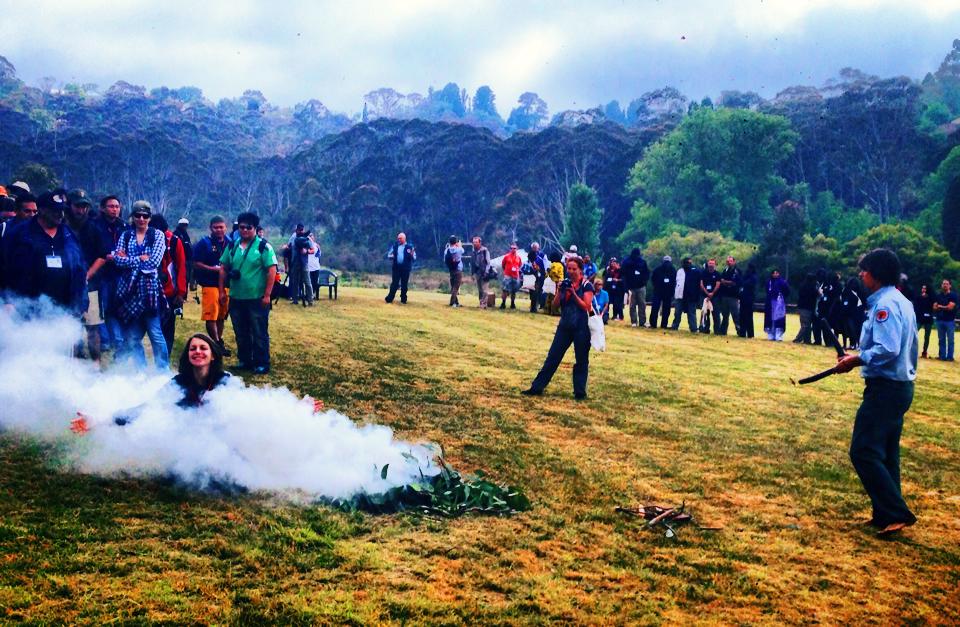 Smoking Ceremony or Smoke and Mirrors?
Staged for the delegates by National Parks and Wildlife Service of New South Wales (NPWS), somewhere outside Sydney, Australia
[Source: ‘Global First Nations environmentalists share stories at the World Parks Congress in Sydney.5:30’, ^https://twitter.com/nitvnews, 20141113] Smoking Ceremony or Smoke and Mirrors?
Staged for the delegates by National Parks and Wildlife Service of New South Wales (NPWS), somewhere outside Sydney, Australia
[Source: ‘Global First Nations environmentalists share stories at the World Parks Congress in Sydney.5:30’, ^https://twitter.com/nitvnews, 20141113]
.
Every ten years a World Parks Congress is a forum staged by the International Union for Conservation of Nature to discuss the effectiveness of World Heritage Listed Protected Areas. For 2014, Parks Australia put up Sydney’s hand to host and fund it.
<<“We (Parks Australia) are delighted to be co-hosting the IUCN World Parks Congress with our colleagues in the New South Wales National Parks and Wildlife Service – and look forward to welcoming inspiring leaders from around the world.”>>
IUCN’s vision is a “just world that values and conserves nature.” The theme for the 2014 conference is “Parks, people, planet: inspiring solutions”.
The last congress was in Durban, South Africa eleven years ago in 2003 and significant messages from that congress were that:
- Considerable progress has been made in the establishment of protected areas although significant gaps remain
- Protected areas face many challenges, and management effectiveness must be strengthened
- Protected areas play a vital role in biodiversity conservation and sustainable development
- A new deal is needed for protected areas, local communities and indigenous peoples
- There is a need to apply new and innovative approaches for protected areas, linked to broader agendas
- Protected areas require a significant boost in financial investment
- Protected areas management must involve young people
.
Congress Cost Benefits ?
.
The obvious first question for the 2014 Sydney Congress is what are the outcomes from these seven messages of 2003?
The second question is what is to be the conservation return on investment of staging the 2014 congress in Sydney? That starts with Parks Australia and NPWS disclosing the full costs of the congress. How much will it have cost by the time this week is over? Five million? Ten million? Twenty million? More? That also involves disclosure of the onground conservation outcomes, if any. The congress hosts more than 5000 delegates for a week-long event in Sydney.
If the answers are not forthcoming and/or the performances less than satisfactory, then perhaps the money could have been better spent (invested) by Parks Australia and NPWS on specific onground conservation of current and worthy Protected Areas in Australia. So the third question is what is the opportunity cost of the 2014 IUCN World Parks Congress which could have delivered the IUCN vision of a “just world that values and conserves nature”?
.
Congress Opportunity Costs
.
According to IUCN director general, Julia Marton-Lefevre, assessments during the past decade have found that half of the world’s protected areas at best — and possibly as few as 20 per cent — are managed effectively. “Some are what we refer to as ‘paper parks’ ” – parks just on paper.
The Australian Government’s $180 million allocation to expand the park reserve system expired last year.
The Great Barrier Reef Marine Park is a case in point. It is the iconic Protected Area in Australia. Its World Heritage listing along with various national zoning, management plans, permits, education and incentives are supposed to protect and conserve the marine ecosystems and migratory species from human threats. But farm and urban runoff continues to contaminate the rivers that flow into the Reef.
In 2009 and 2011, mining company Queensland Nickel discharged nitrogen-laden water and 516 tonnes of toxic waste water into the Great Barrier Reef.
On 21 July 2013, on the second day of the biennial joint training exercise Talisman Saber, two American AV-8B Harrier fighter jets launched from aircraft carrier USS Bonhomme Richard (LHD-6) dropped four bombs, weighing a total 1.8 metric tons (4,000 pounds), into more than 50 metres (164 ft) of water. On 3rd April 2010, The Shen Neng 1, a Chinese ship carrying 950 tonnes of oil, ran aground, causing the 2010 Great Barrier Reef oil spill.
In December 2013, Greg Hunt, the Australian environment minister, approved a plan for dredging to create three shipping terminals as part of the expansion of an existing coal port. According to corresponding approval documents, the process will create around 3 million cubic metres of dredged seabed that will be dumped within the Great Barrier Reef Marine Park.
On 31 January 2014, a permit was issued to allow three million cubic metres of sea bed from Abbot Point, north of Bowen, to be transported and unloaded in the waters of the Great Barrier Reef Marine Park, just outside of Abbot Bay. The dredge spoil will cloud the water and block sunlight, thereby starving sea grass and coral up to distances of 80 km away from the point of origin due to the actions of wind and currents. The dredge spoil will smother reef or sea grass to death, while storms can repeatedly resuspend these particles so that the harm caused is ongoing; secondly, disturbed sea floor can release toxic substances into the Great Barrier Reef Marine Park.
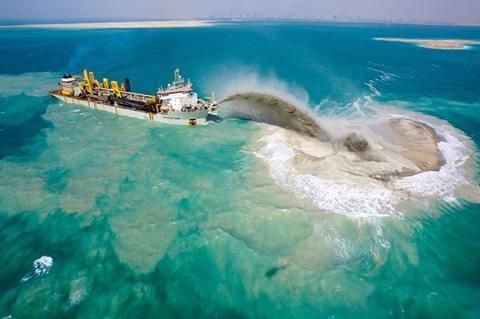 Dredging the Great Barrier Reef for bulk export shipping Dredging the Great Barrier Reef for bulk export shipping
.
The Great Barrier Reef Marine Park has become just a blue line on a map. The trickle of funds for Australia’s national parks betrays a lack of appreciation of their economic contribution. Annual funding for the authority that runs Australia’s most famous reserve, the Great Barrier Reef Marine Park, is about 1 per cent of the $5.2bn it earns the country in tourism revenue.
Yet if the IUCN World Parks Congress cost a conservative $20 million to stage then a key opportunity cost would be the June 2014 Federal budget cuts to the Great Barrier Reef Marine Park Authority.
The budget axed 17 staff including five of its’ directors positions. These positions included the director of heritage conservation, the director of policy and governance and the director of coastal ecosystems and water quality as part of an internal restructure. It’s being described as the greatest loss of expertise from Australia’s most important natural wonder and it comes at the very time the Great Barrier Reef is facing the greatest threat to its survival.
The Greater Barrier Reef Marine Park Authority has been reduced by the Australian Government to being in name only and ineffective at protecting the reef.
Until recently, one of those five directors, Adam Smith, was charged with dealing with the contentious Abbot Point coal terminal development and the proposal to dump three million cubic metres of dredge spoil into the marine park. Despite Dr Smith’s concerns, the sea dumping was approved by the Marine Park Authority.
Dr Smith has since accepted voluntary redundancy and moved on after disagreeing with the Authority’s new economic leadership and values. Heritage conservation director Jon Day has left after 21 years, disillusioned too with the direction the Authority has taken to compromise the reef.
Next year UNESCO will decide whether to put the reef on its world heritage in danger list. Native Dugongs are already endangered. The deliberate extermination of the dugong and turtles which habituated the Gladstone area is a national tragedy. Dugongs are species listed under the Federal Environment Protection Biodiversity & Conservation Act, which requires the Federal government to legally protect these animals.
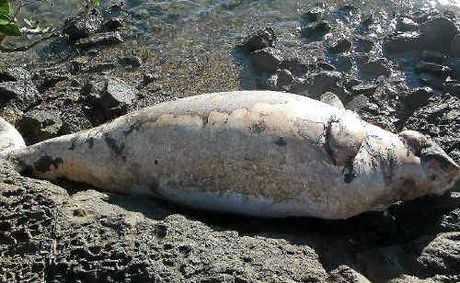
Prior to the massive dredging operation of 52 million cubic metres of seabed for the development of the world’s largest LNG Terminal, ( which is 62% completed) a study commissioned by the Gladstone Ports Corporation found that a take, or a quota, of more than zero dugongs would be unsustainable.
In the face of massive mortality of dugongs, turtles and inshore dolphins during the ongoing massive dredging, both the Federal and Queensland governments ignored the slaughter.
Look at the stranding data from the Queensland Department of Environment and Resource Management. Monthly cumulative Dugong strandings by year for Queensland, up to 31 January 2012.
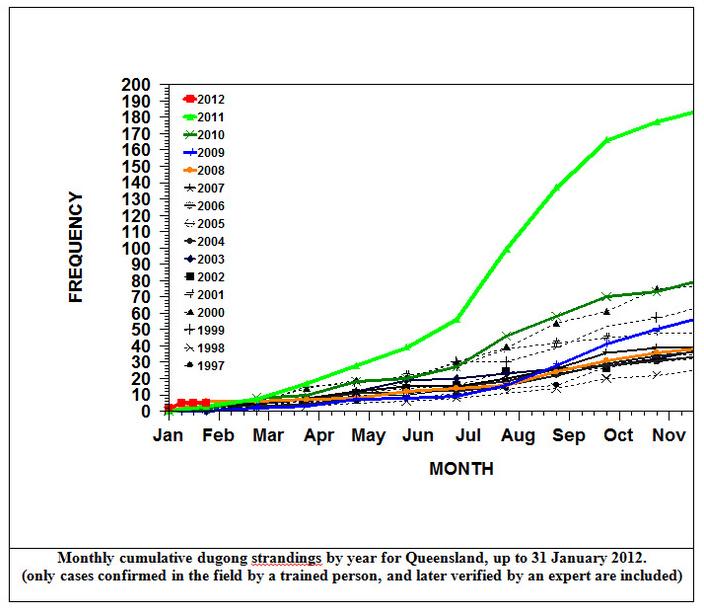
There are 22,000 vessel movements a month in Gladstone Harbour. No ship strikes of Dugongs or of Green Turtles need to be reported. No audit of environmental conditions has been undertaken by the Queensland or Federal Governments. The wholesale slaughter of our marine wildlife is the price Australians are paying for the transformation of the Great Barrier Reef World Heritage Area into the world’s largest unregulated quarry.
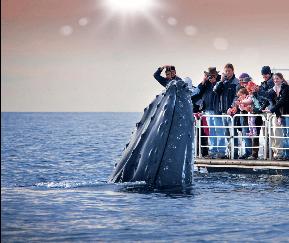 Mass tourism operators good for the economy
Getting up close to protected Humpback Whales within their 100 metre Protected Area Mass tourism operators good for the economy
Getting up close to protected Humpback Whales within their 100 metre Protected Area
.
Australian protected areas have seen rule changes in the eastern states have allowed cattle to graze, recreational shooters to hunt and hotel developers to build in national parks. Shore-based recreational fishing has been allowed in areas of NSW marine parks previously zoned as no-take sanctuaries. National parks on land and in the ocean are dying a death of a thousand cuts, in the form of bullets, hooks, hotels, logging concessions and grazing licences.
Yet as host of the 2014 World Parks Congress, Australia is showcasing “our own inspiring places, inspiring people and inspiring solutions.” The Global Eco Forum within the Congress programme focuses on tourism exploitation of Protected Areas because like the new Greater Barrier Reef Marine Park Authority, the new values are not about conservation by the billions in revenue opportunity to Australia’s economy.
The October 2006 issue of National Geographic published an article “The Future of Parks: Hallowed Ground – Nothing is Ever Safe”.
It stated:
“Landscape and memory combine to tell us certain places are special, sanctified by their extraordinary natural merits and by social consensus.
We call those places parks, and we take them for granted.”
.
Sydney’s 2014 World Parks Congress appears to be expensive window dressing, showcasing fraudulent conservation of Protected Areas in Australia.
It’s termed Greenwashing. The opportunity cost of the 2014 Congress could have instead funded the retention of the previously effective Great Barrier Reef Marine Park Authority and so done more for Protected Areas than all the pomp, promising, luncheons, showcasing, and talk-festing of the congress combined.
.
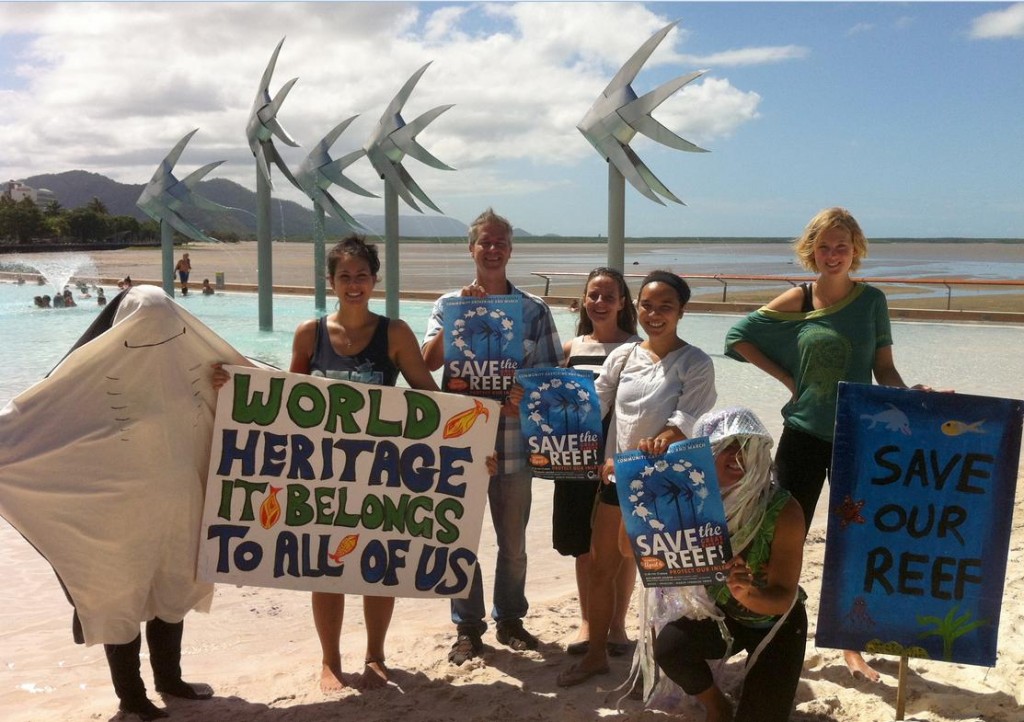 Protest to stop Queensland Resources Council dumping dredge spoil inside the Reef
Protest by Cairns and Far North Environment Centre (CAFNEC), June 2014
^http://cafnec.org.au/wp-content/uploads/2014/03/rally-promo-photo.jpg Protest to stop Queensland Resources Council dumping dredge spoil inside the Reef
Protest by Cairns and Far North Environment Centre (CAFNEC), June 2014
^http://cafnec.org.au/wp-content/uploads/2014/03/rally-promo-photo.jpg
.
Further Reading:
.
[1] IUCN World Parks Congress (Sydney 2014), International Union for Conservation of Nature, ^http://worldparkscongress.org/
.
[2] ‘Global Eco-Tourism in Protected Areas‘, by EcoTourism Australia, >2014 Global Eco Tourism in Protected Areas.pdf (1.1MB, 2 pages)
.
[3] Great Barrier Reef Marine Park Authority (website), Australian Government, ^http://www.gbrmpa.gov.au/
.
[4] Fight for The Reef (website), Australian Marine Conservation Society, ^https://fightforthereef.org.au/risks/dredging/
.
[5] No Hunting in National Parks (website), The National Parks Association of NSW, ^http://nohunting.wildwalks.com/
.
[6] ‘An international perspective on tourism in national parks and protected areas‘, by J.G. Castley (2014), >An international perspective on tourism in national parks and protected areas.pdf (100kb, 10 pages)
.
[7] ‘EXTRA: ‘Nasho’, Royal National Park, Sydney’s neglected southern jewel‘, by Nick Galvin, Journalist, Sydney Morning Herald, 20140613, ^http://www.smh.com.au/nsw/extra-nasho-royal-national-park-sydneys-neglected-southern-jewel-20140613-zs6d8.html
.
[8] ‘Paradise lost: Australia’s heritage jewels under threat‘, (audio), ABC ‘Background Briefing’ radio programme, by Sarah Dingle, 20131208, ^http://www.abc.net.au/radionational/programs/backgroundbriefing/2013-12-08/5132224
.
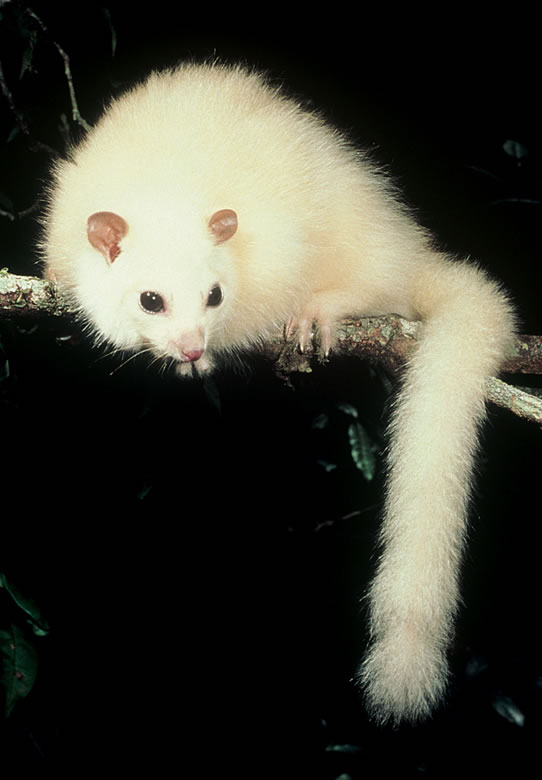 White Lemuroid Possum
(Wet Tropics of Queensland World Heritage Area in Danger)
Has the white lemuroid possum become the first mammal to go extinct due to global warming? White Lemuroid Possum
(Wet Tropics of Queensland World Heritage Area in Danger)
Has the white lemuroid possum become the first mammal to go extinct due to global warming?
The species, normally found above 1000m, has not been sighted during any nighttime spotlighting expedition since 2005. Experts fear a temperature rise of 0.8 degrees Celsius may be to blame for the animal’s disappearance.
[Source: ^http://www.wherelightmeetsdark.com/index.php?module=newswatch&NW_user_op=view&NW_id=453]
.
Tags: Dugong, Dugong strandings, Gladstone Harbour, Great Barrier Reef, Great Barrier Reef Marine Park, Green Turtle strandings, greenwashing, Humpback Whale, International Union for Conservation of Nature, iucn, national parks, National Parks and Wildlife Service, Parks Australia, Protected Areas in Australia, Queensland Government, The Great Barrier Reef Marine Park Authority, UNESCO world heritage in danger list, Wet Tropics of Queensland World Heritage Area in Danger, White Lemuroid Possum, World Heritage, World Parks Congress
Posted in Critically Endangered Wildlife (CR), Threats from Government Funding Neglect, Threats from Greenwashing, Threats from Pollution, Threats from Tourism and Recreation, Threats from Weak Environmental Laws | No Comments »
Add this post to Del.icio.us - Digg
Monday, May 20th, 2013
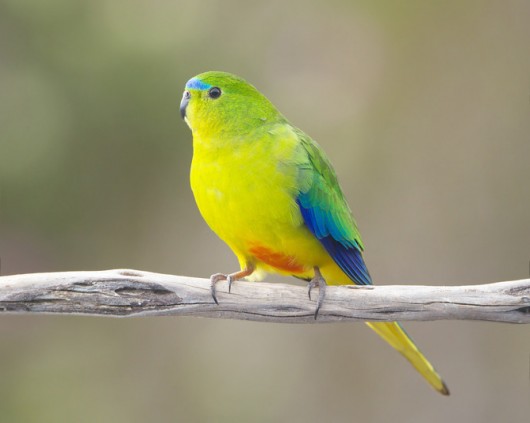 Orange-Bellied Parrot (Neophema chrysogaster)
Critically endangered and breeds only in Tasmania, Australia
[Source: Photo by John Harrison, in article ‘Threat of extinction demands fast and decisive action’, 20120724, by Tara Martin, published in The Conversation,
^http://theconversation.com/threat-of-extinction-demands-fast-and-decisive-action-7985] Orange-Bellied Parrot (Neophema chrysogaster)
Critically endangered and breeds only in Tasmania, Australia
[Source: Photo by John Harrison, in article ‘Threat of extinction demands fast and decisive action’, 20120724, by Tara Martin, published in The Conversation,
^http://theconversation.com/threat-of-extinction-demands-fast-and-decisive-action-7985]
.
Government Ecological Hypocrisy
.
While Australia’s governments at federal and state level continue to allow and encourage logging, burning and mining of Australia’s native forest ecosystems, many conservationists are well aware of that the loss of these forests habitats, and other human harmful actions are driving the extinction of Australia’s flora and fauna.
Threatened species can only be saved from extinction if first their habitat is properly protected from harm. Many species such as the Orange-Bellied Parrot which has now become critically endangered require more than just habitat protection, but active recovery intervention to save it from extinction. Yet this parrot species’ native habitats restricted to southern coastal Victoria and Tasmania are actively being destroyed as if government were sadistically and callously encouraging its extinction.
In governments we trust. Yet infamously in July 2009, the man who used to belt out “And the company takes what the company wants/And nothing’s as precious as a hole in the ground”, Midnight Oil’s Peter Garrett, as then entrusted Environment Minister, approved the Beverley Four Mile Uranium Mine in South Australia.
[Source: ‘Why Peter Garrett lost his way’, August, 2009, by David Glanz ^http://www.solidarity.net.au/best/why-peter-garrett-lost-his-way/]
.
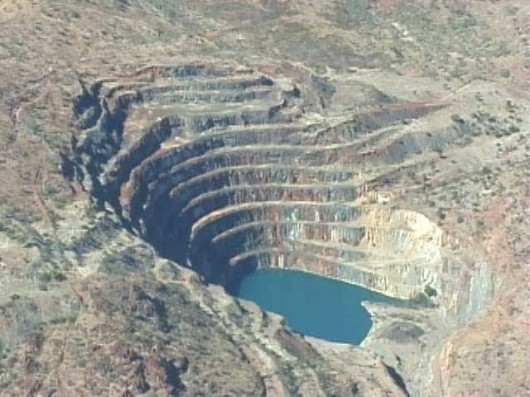 Beverley Four Mile Uranium Mine
550km north east of Adelaide Beverley Four Mile Uranium Mine
550km north east of Adelaide
.
At the most senior level, the Australian Government minister who is ultimately responsible and accountable to protect Australia’s natural ecology and to prevent flora and fauna extinctions, has his environment task diluted. Tony Burke MP is currently the Minister for (1) Sustainability (2) Environment (3) Water (4) Population (5) Communities (6) the Arts, which reflects the low value that the Australian Government places on protecting Australia’s Ecology.
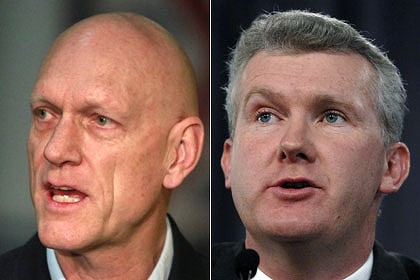 Australia’s recent Environment Ministers, respectively Peter Garrett and Tony Burke
Both Babyboomer Middle-Aged Men
Invariably in business, in politics, Babyboomer Middle-Aged Men
are the demographic drivers of ecological destruction across the planet. Australia’s recent Environment Ministers, respectively Peter Garrett and Tony Burke
Both Babyboomer Middle-Aged Men
Invariably in business, in politics, Babyboomer Middle-Aged Men
are the demographic drivers of ecological destruction across the planet.
.
Tony Burke has recently approved open coal mining that will destroy the Leard State Forest in New South Wales, remnant home of the increasingly rare Koala [^Read More].
Tony Burke has approved mining in Tasmania’s Tarkine (the last continuous wilderness region of Gondwana Rainforest home to more than 60 species of rare, threatened and endangered species including the Giant Freshwater Lobster, the Wedge Tailed Eagle, the Tasmanian Devil and the Orange-bellied Parrot [^Read More].
Tony Burke has recently approved logging to continue in recognised high conservation value native forests in Tasmania, previously agreed to be protected in an Intergovernmental Agreement between the federal and Tasmanian governments in Launceston on 7th August 2011 [^Read More].
Tony Burke has recently approved port development and shipping movements through the Great Barrier Reef for Rio Tintos’ bauxite mine in western Cape York, as well as a huge new coal export terminal at Abbot Point and at dredging of Gladstone Harbour despite the ongoing damage vital marine habitat supporting endangered species including turtles, dugongs and dolphins. [^Read More]
.
“For the powerful, crimes are those that others commit.”
~ Noam Chomsky, Imperial Ambitions: Conversations on the Post-9/11 World
.
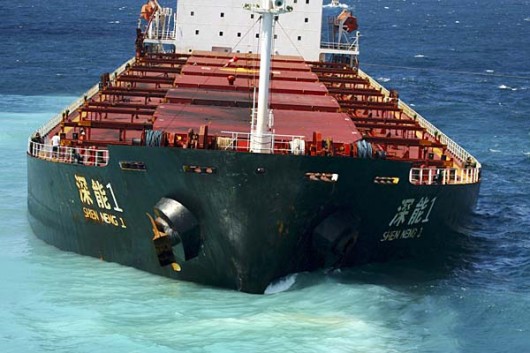 The 100 tonne coal ship the ‘Shen Neng 1’ which went aground on 5th April 2010, while negotiating the Great Barrier Reef
The ship destroyed 3km of the coral Douglas Shoal which it “completely flattened” and “pulverised” marine life. The marine park authority’s chief scientist, Dr David Wachenfeld, expressed concerned also about the toxic heavy metal anti-fouling paint scraping off the hull.
[Source: ‘Three kilometres of Great Barrier Reef damage, 20 years to mend’, 20100414, by Tom Arup, The Age newspaper,
^http://www.theage.com.au/environment/three-kilometres-of-great-barrier-reef-damage-20-years-to-mend-20100413-s7p8.html] The 100 tonne coal ship the ‘Shen Neng 1’ which went aground on 5th April 2010, while negotiating the Great Barrier Reef
The ship destroyed 3km of the coral Douglas Shoal which it “completely flattened” and “pulverised” marine life. The marine park authority’s chief scientist, Dr David Wachenfeld, expressed concerned also about the toxic heavy metal anti-fouling paint scraping off the hull.
[Source: ‘Three kilometres of Great Barrier Reef damage, 20 years to mend’, 20100414, by Tom Arup, The Age newspaper,
^http://www.theage.com.au/environment/three-kilometres-of-great-barrier-reef-damage-20-years-to-mend-20100413-s7p8.html]
.
Threatened Species Scientific Committee
– a toothless agency abused for ecopolitical spin
.
Then, at a lower level of government, a committee has been established since 2000 to advise Australia’s Environment Minister on issues associated with Australia’s increasing list of threatened species.
The Threatened Species Scientific Committee (TSSC) is legally established for under the Environment Protection and Biodiversity Conservation Act 1999 (EPBC Act), which superseded the 1992 Endangered Species Protection Act. The committee’s function is to advise the Minister for Sustainability, Environment, Water, Population and Communities (currentky Tony Burke MP) on:
- Amendments and updating of threatened species and threatened ecological communities lists
- Key Threatening Processes
- Preparing Species Recovery Plans and Threat Abatement Plans
- Scientific input into the Species Profile and Threats Database (^SPRAT)
- Advice on the presence of hybrids in listed ecological communities
- Hold periodic workshops dealing with issues concerning Australia’s threatened species and threatened ecosystems
.
Every year the committee publishes an annual report, except it has been six years since the Australian Government published one on its website. Here is the latest report from 2006-07. [>Read 2006-07 Report.pdf , 40kb) ]
.
[Source: ‘Threatened Species Scientific Committee’, ^http://www.environment.gov.au/biodiversity/threatened/committee.html]
.
Australia’s Threatened Fauna
.
As at the date of this article, the Australian Government lists the following statistics as our native fauna currently threatened with extinction to varying degrees, or now extinct.
Beware that government websites can change with whim and so the existence of the link below may disappear at any time.
.
Extinct:
- frogs (4)
- birds (23)
- mammals (27)
- other animals (1)
.
Extinct in the wild:
.
Critically Endangered:
- fishes (6)
- frogs (5)
- reptiles (4)
- birds (7)
- mammals (4)
- other animals (21)
.
Endangered:
- fishes (16)
- frogs (14)
- reptiles (16)
- birds (44)
- mammals (35)
- other animals (17)
.
Vulnerable:
- fishes (24)
- frogs (10)
- reptiles (36)
- birds (60)
- mammals (55)
- other animals (11)
.
Conservation dependent:
.
Total Threatened Fauna Species: (445)
.
[Source: Australia’s Threatened Flora, 2013, ^http://www.environment.gov.au/cgi-bin/sprat/public/publicthreatenedlist.pl]
.
Australia’s Critically Endangered Mammals
.
The above list is out of date, and the International Union for Conservation of Nature (IUCN) records are also out of date, because of the lack of diligent timely monitoring efforts by the Australian Government, and tardiness by the Australian Government in updating pertinent threatened species information back to the IUCN. Basically the Australian Government simply doesn’t care enough about Australian Ecology and dependent species about to become extinct.
It is a dire situation disgracefully detestable and sad.
According to an article in The Conversation back in December 2012, in respect to Australian mammal fauna, there are not four species deemed to be critically endangered to extinction, but now twelve, as listed below. Some of these may well be extinct such as the Christmas Island Pipistrelle..
The plight and demise of these species is not new. The Australian Government and its committees, reviews, reports and laws have confirmed this for many years. More committees, reviews, reports and laws equates to unforgiveable avoidance of moral and legal responsibility by the incumbent Environment Minister, this man:
.
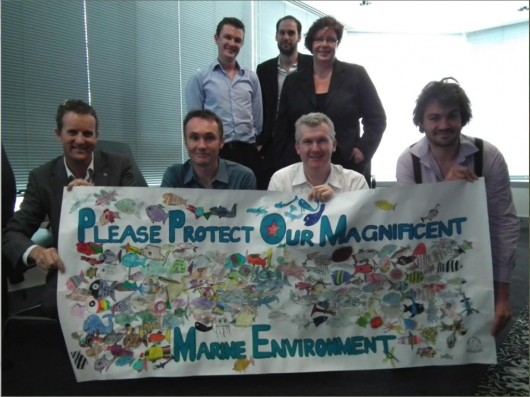 Tony Burke – the only grey haired Babyboomer in this photo
His demographic is responsible for the worst destruction of ecology across the Planet,
because the Nature-compromising values of males in this generation were formed when Nature was still considered plenty and its exploitation a God-given gospel.
Tony Burke’s values are wrong, inappropriate and his powerful decisions irreversible. Tony Burke – the only grey haired Babyboomer in this photo
His demographic is responsible for the worst destruction of ecology across the Planet,
because the Nature-compromising values of males in this generation were formed when Nature was still considered plenty and its exploitation a God-given gospel.
Tony Burke’s values are wrong, inappropriate and his powerful decisions irreversible.
.
- Woylie (Bettongia penicillata) also known as the Brush-tailed Bettong, or Brush-tailed Rat Kangaroo; a small marsupial found from south-west Western Australia across southern Australia.
- Mountain Pygmy Possum (Burramys parvus) – this tiny possum occurs as three isolated, genetically distinct populations in the alps of Victoria and NSW.
- Christmas Island Shrew (Crocidura trichura) – endemic to Christmas Island and hasn’t been seen since 1985. It is possibly extinct.
- Northern Hairy-nosed Wombat (Lasiorhinus krefftii) – approximately 200 of these wombats remain; they are limited to Epping Forest National Park (Scientific), and a reintroduced population at the Richard Underwood Nature Refuge, in Queensland.
- Lesser Stick-nest Rat (Leporillus apicalis) – this central-Australian rodent is probably extinct, with no reliable sightings since 1970.
- Bramble Cay (Melomys Melomys rubicola) – limited to a small cay in the Torres Strait, this rodent has one of the most restricted distributions of any mammal species.
- Lord Howe Long-eared Bat (Nyctophilus howensis) – known only from a single skull found in 1972, but Lord Howe Islanders continue to report bat sightings.
- Christmas Island Pipistrelle (Pipistrellus murrayi) – while listed as critically endangered, it’s generally accepted this little bat is now extinct.
- Gilbert’s Potoroo (Potorous gilbertii) – only 40 or so of these rabbit-sized marsupials live in south-west Western Australia, but the population seems stable.
- Kangaroo Island Dunnart (Sminthopsis aitkeni) – this little hand-sized marsupial is restricted to a very small area of Kangaroo Island.
- Carpentarian Rock Rat (Zyzomys palatalis) – a rodent found in sandstone gorges in the Northern Territory, there are thought to be less than 2000 remaining.
- Central Rock Rat (Zyzomys pedunculatus) – this rodent is found only in the western MacDonnell Ranges in the Northern Territory.
.
[Source: ‘Australia’s critically endangered animal species’, 20121206, by Jane Rawson, The Conversation, ^http://theconversation.com/australias-critically-endangered-animal-species-11169]
.
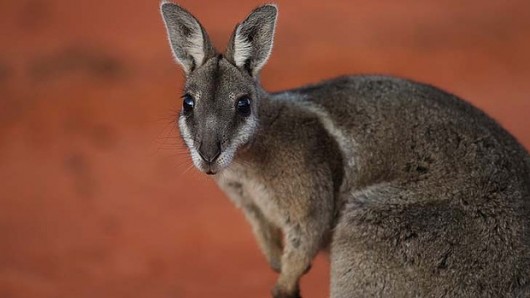 On the brink of extinction: the Bridled Nailtail Wallaby
[Source: Photo by Kate Geraghty, Dead and dying: our great mammal crisis’, 20121117, by Tim Flannery, The Age newspaper,
^http://www.theage.com.au/national/dead-and-dying-our-great-mammal-crisis-20121116-29hi9.html] On the brink of extinction: the Bridled Nailtail Wallaby
[Source: Photo by Kate Geraghty, Dead and dying: our great mammal crisis’, 20121117, by Tim Flannery, The Age newspaper,
^http://www.theage.com.au/national/dead-and-dying-our-great-mammal-crisis-20121116-29hi9.html]
.
Leadership, Accountability, Timely Action
.
According to Tara Martin, Research Scientist at Ecosystem Sciences at the CSIRO:
<<When it comes to mammal extinctions, Australia’s track record over the last 200 years has been abysmal. Since European settlement, nearly half of the world’s mammalian extinctions have occurred in Australia – 19 at last count. So, when faced with the additional threat of climate change, how do we turn this around and ensure the trend doesn’t continue?
Learning from previous extinctions is a good place to start. A comparison between two Australian species, the recently extinct Christmas Island pipistrelle and the critically endangered but surviving orange-bellied parrot, provides some insight into the answer to this question. Namely, that acting quickly and decisively in response to evidence of rapid population decline is a key factor in determining the fate of endangered species.
.
‘Government Delay condemn a species to extinction’
A Case of Government Delay:
.
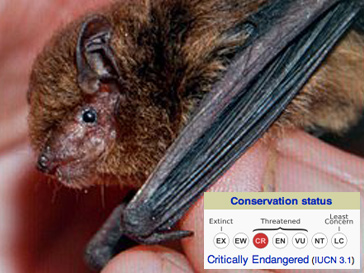 Species Extinction on Peter Garrett’s Watch
<< The Australian Government will invest $1.5 million to begin the rescue of Christmas Island’s ecosystem, including a mission to capture the last remaining Pipistrelle bats for captive breeding. “Volunteers and help from the Australasian Bat Society will be invaluable in this capture effort.” “My top priority now is to prevent any further extinctions and to restore the island’s environmental health,” Mr Garrett said.>>
A year later the critically endangered Christmas Island Pipistrelle (Pipistrellus murrayi) was declared extinct. Species Extinction on Peter Garrett’s Watch
<< The Australian Government will invest $1.5 million to begin the rescue of Christmas Island’s ecosystem, including a mission to capture the last remaining Pipistrelle bats for captive breeding. “Volunteers and help from the Australasian Bat Society will be invaluable in this capture effort.” “My top priority now is to prevent any further extinctions and to restore the island’s environmental health,” Mr Garrett said.>>
A year later the critically endangered Christmas Island Pipistrelle (Pipistrellus murrayi) was declared extinct.
[Source: ‘Christmas Island Pipistrelle Rescue’, 20090703, by Bat Conservation & Rescue Qld Inc., ^http://www.bats.org.au/?p=710]
.
<<Endemic to Christmas Island, the pipistrelle was a tiny (3.5 gram) insect-eating bat. It was first described in 1900, when numbers were widespread and abundant. In the early 1990s this began to change. The decline was rapid and the exact cause uncertain.
By 2006, experts were calling for a captive breeding program to be initiated. These pleas were ignored until 2009 when it was finally given the green light. Sadly the decision came too late, and two months (the then Minister for the Environment, Heritage and the Arts, Peter Garrett MP) announced that the rescue attempt had failed.>>
.
A Case of Government Action (so far):
.
<<Concern about the orange-bellied parrot began in 1917, but it wasn’t until 1981 that it was confirmed to be on the brink of extinction. In an attempt to save the parrot, a multi-agency, multi-government recovery team was set up and a captive breeding program began in 1983.
Like the bat, threats to the parrot remain poorly understood. In 2010, monitoring showed that the species would become extinct in the wild within three to five years unless drastic action was taken. The recovery team immediately took action to bolster the captive population as insurance against extinction. There are currently 178 birds in captivity and less than 20 in the wild.
.
<<…How we manage endangered species ultimately comes back to the decisions made, including who makes the decisions, who is held accountable, and the timing of these decisions.
Examining these cases in the context of decision-making reveals some clear differences and highlights some important recommendations for the future management of endangered species.
One of the key differences was in the governance and leadership surrounding the two cases. Experts involved in monitoring the pipistrelle provided recommendations to government bodies, but did not have the authority to make decisions nor was there an effective leader to champion the urgent need to act. Conversely, the Orange-bellied Parrot Recovery Team had the authority to make decisions and act on them. Indeed, thanks to the Recovery Team’s broad representation, any failure to act would likely have resulted in public outcry – which raises the issue of accountability.
Management of endangered species requires tough decisions, yet they are decisions we must make. If we monitor declining populations without a process for deciding between different management options, we will only document extinctions. In some cases, the logical decision may be to employ a triage system where priority is given to species with a high likelihood of recovery. Assigning institutional accountability around the management of endangered species could help to ensure that tough decisions are made and that the processes involved are transparent.
Finally, the cases of the bat and the parrot also highlight the need to act quickly when a species is found to be on the brink of extinction. Delaying decisions only narrows our choices and removes opportunities to act. We may not always have all the answers, but this cannot be used as a reason to delay decision making. Based on a triage system a decision to not to act might be the best way forward, but if we delay the decision it becomes the only way forward.
..scientific analysis can be used to determine how much information we need to inform a good conservation decision. In the case of the Christmas Island pipistrelle, the decision to start a captive breeding program came many years too late.
By evaluating the costs, benefits, and feasibility of taking different management actions in the light of what we know about a species’ decline (or don’t know – i.e. the degree of uncertainty), it is possible to get the timing right.
Research into the methods used to stem species decline is also underway. For example, captive breeding and reintroduction programs are generally regarded as having good success rates. Further investigation into genetic management, habitat restoration, and effective techniques for reintroduction and risk management will help ensure the success of these programs for a variety of species.
Stemming the global loss of biodiversity through Species Recovery Planning will require brave decision-making in the face of uncertainty. Monitoring must be linked to decisions, institutions must be accountable for these decisions and decisions to act must be made before critical opportunities, and species, are lost forever.>>
.
[Source: ‘Threat of extinction demands fast and decisive action’, 20120724, by Tara Martin, Research Scientist, Ecosystem Sciences at CSIRO, (based on a paper by Tara Martin and with input from co-authors Mark Holdsworth, Stephen Harris, Fiona Henderson, Mark Lonsdale, in The Conversation, ^http://theconversation.com/threat-of-extinction-demands-fast-and-decisive-action-7985]
.
.
Principles to Properly Protect Threatened Species
.
The Australian Government is accountable for the conservation of Australia’s natutral environment and dependent species, particularly those at risk of extinction. It is charged with the democratic authority to do so and the Australian people entrust it to act responsibly. The Australian Government since 1999 had in place a national law protecting threatened species under its Environment Protection and Biodiversity Conservation Act, and since 2000 had an expert Threatened Species Scientific Committee advising it on priorities for threatened species and key threatening processes and recommended conservation actions.
But having a framework for conservation action is two steps short of the conservation action itself. Without proper funding and timely onground action, government environmental conservation is but hypocritcal lip service.
.
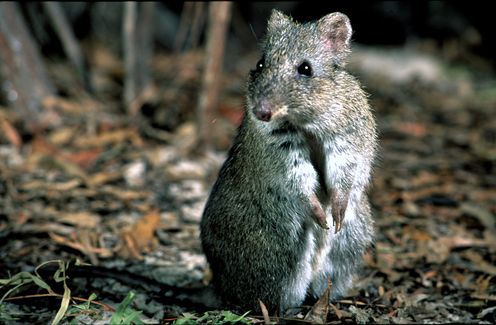 Gilbert’s Potoroo – only 40 left Gilbert’s Potoroo – only 40 left
.
2008 Review of Threatened Species Protection
.
Section 522A of the EPBC Act requires it to be reviewed every 10 years from its commencement. So on 31 October 2008, Peter Garrett MP as the then Minister for the Environment, Heritage and the Arts, commissioned an independent review of the Environment Protection and Biodiversity Conservation Act 1999 (EPBC Act), the Australian Government’s central piece of environmental legislation.
The Terms of Reference were:
- the operation of the EPBC Act generally
- the extent to which the objects of the EPBC Act have been achieved
- the appropriateness of current matters of National Environmental Significance
- the effectiveness of the biodiversity and wildlife conservation arrangements
- Seek input from state and territory governments, members of the community and industry
.
The review to be guided by key Australian Government policy objectives:
- To promote the sustainability of Australia’s economic development to enhance individual and community well-being while protecting biological diversity and maintaining essential ecological processes and systems
- To work in partnership with the states and territories within an effective federal arrangement
- To facilitate delivery of Australia’s international obligations
- The Australian Government’s deregulation agenda to reduce and simplify the regulatory burden on people, businesses and organisations, while maintaining appropriate and efficient environmental standards
- To ensure activities under the Act represent the most appropriate, efficient and effective ways of achieving the Government’s outcomes and objectives in accordance with the Expenditure Review Principles.
.
The review was undertaken by Dr Allan Hawke (government representative) supported by a panel of experts- a retired NSW judge Paul Stein AM, Professor Mark Burgman (Environmental Science), Professor Tim Bonyhady (Environmental Law), Rosemary Warnock (ethical standards and the environment).
Community participation in the review was encouraged and 220 written submissions were received and 140 face-to-face consultation meetings were held in capital cities around Australia. An Interim Report on the review was released and a further 119 written comments were received. The Final Report was delivered to the Minister on 30 October 2009 and publicly released on 21 December 2009.
On 24 August 2011, the Minister released the Australian Government response to the independent review, three years after the review process began and about a year after the ten year review deadline.
The response centred around four key themes:
- Abandonning targeted actions to save critically endangered threatened species, and instead to vague “strategic approaches” and more plans
- Simplification of the assessment and approval processes for threatened species – vague, cheaper and less research work
- Big picture ecosystem approach
- Compromise of national standards to “harmonise” conservation approaches with the States having different priorities
.
Irrespective of the 220 written submissions and 140 face-to-face consultation meetings, out of the 71 recommendations in the Final Report, the Australian Government agreed either in part, in principle, in substance, but has since done precious little to protect Australia’s threatened species.
The review process was stipluated in the EPBC Act, but all it achieved was an opportunity for the Australian Government to undermine the 1999 standards, water down national environmental protection legislation, simplify the government’s administration and save money. Effectively the EPBC Review was a bureacratic talk fest and an expensive waste of time and taxpayer money that would have been better spent on implementing known critically endengerd species and their habitats.
The survival of Australia’s threatened species remain at the whim of federal and state governments.
What did the entire review process cost including the consultants? The amount is secret. Was it $10 million, more? The estimated cost of a Species Recovery Plans and Threat Abatement Plan to save the critically endangered Orange-bellied Parrot is how much?
Meanwhile, as few as 250 Orange-bellied Parrots remain in existence, making the species one of the most endangered species on the planet.
Meanwhile, community volunteers with The Friends of the Orange-Bellied Parrot and Wildcare Inc. in Tasmania continue to monitor the Orange-bellied Parrots during their breeding season in far southwest Tasmania’s Wilderness World Heritage Area. Members live for periods of 10 days at Birch Inlet and Melaleuca in Tasmania’s Wilderness World Heritage Area, making observations of the daily lives of the OBPs, including birds that have been bred in captivity and released at the beginning of the season as part of the Species Recovery Plan for the Orange-Bellied Parrot.
They don’t get money from the Australian Government and so have set up the Save the Orange-bellied parrot Fund. Wildcare Inc volunteers receive a small reimbursement allowance from the Tasmanian Government’s watered down Department of (1) Primary Industries, (2) Parks, (3) Water and oh yeah (4) Environment to assist with their costs.
.
[Source: Wildcare Incorporated, Tasmania, ^http://www.wildcaretas.org.au/]
.
.
.
.
.
[Source: Australian Government, ^http://www.environment.gov.au/epbc/review/]
.
2012 Review of Threatened Species Protection
.
After the entire the EPBC Act Review process and a year after the Australian Government’s response to it, on 31 October 2012 the Australian Senate this time set up yet another review into the Effectiveness of Threatened Species and Ecological Communities’ Protection in Australia. It commissioned a Senate Standing Committee on Environment and Communications for enquiry and report.
This second review process came in light of the rubber stamp realisation by The Greens Senator Larissa Waters of how the Australian Government had poorly treated the EPBC Review and in light of the Auditor General report that Victoria’s environment and primary industry departments are failing to act as proper watchdogs [^Read More]. Further to that we’ve seen Professor Tim Flannery publish his opinion piece (from the Monthly’s Quarterly Essay) on the extinction crisis pointing some of the blame at the Commonwealth’s inaction [^Read More].
Public submissions were to be received by 14th December 2012 and the reporting date scheduled to be 7th February 2013, but rather late again on 14th May 2013, the Senate granted an extension of time for reporting until 20 June 2013 (one month’s time from the date of this article).
The Terms of Reference are:
(a) Management of key threats to listed species and ecological communities
(b) Development and implementation of Species Recovery Plans
[Ed: About time, and what about commensurate Threat Abatement Plans? One is ineffective without the other.]
(c) Management of critical habitat across all land tenures
(d) Regulatory and funding arrangements at all levels of government
(e) Timeliness and risk management within the listings processes
(f) The historical record of state and territory governments on these matters
(g) Any other related matter.
.
[Sources: ‘The effectiveness of threatened species and ecological communities’ protection in Australia’, Terms of Reference, Australian Senate,^http://www.aph.gov.au/Parliamentary_Business/Committees/Senate_Committees?url=ec_ctte/threatened_species/tor.htm; ‘Threatened species in the senate spotlight’, 20121121, Councillor Samantha Dunn, Shire of Yarra Ranges, Victoria, Australia (website), ^http://crdunn.blogspot.com.au/2012/11/threatened-species-in-senate-spotlight.html]
.
Public submissions received by the Senate Committee
.
1 Mr Gabriel Lafitte (PDF 39KB)
2 Dr Todd Soderquist and Dr Deborah Ashworth (PDF 41KB) Attachment 1(PDF 395KB)
3 Mr Marcus Coghlan (PDF 91KB)
4 Australasian Native Orchid Society and the Australian Orchid Council (PDF 309KB)
5 Ms Fay Jones (PDF 4KB)
6 Monaro Acclimatisation Society Inc (PDF 267KB)
7 Mr James Samargis (PDF 56KB)
8 Mr Stephen Chara (PDF 432KB), Supplementary Submission(PDF 1213KB)
9 Mr Sab Lord, Lords Kakadu and Arnhemland Safaris (PDF 9KB)
10 Ms Kylie Jones (PDF 43KB)
11 East Gippsland Wildfire Taskforce Inc (PDF 1483KB)
12 Regent Honeyeater Project (PDF 9KB) Attachment 1(PDF 2946KB)
13 Mr Rob Brewster (PDF 2063KB)
14 Mr Tom Kingston (PDF 16KB)
15 Professor David Lindenmayer (PDF 44KB)
16 Mr Frank Manthey OAM, Save the Bilby Fund (PDF 189KB), Supplementary Submission(PDF 1154KB)
17 Friends of Tootgarook Wetland Reserves (PDF 390KB)
18 Mr Jim Walker (PDF 193KB)
19 Ms Harriett Swift (PDF 34KB), Supplementary Submission(PDF 11KB)
20 Island Conservation (PDF 1011KB)
21 Wildflower Society of Western Australia (Inc) (PDF 161KB)
22 Mr Daniel Bell (PDF 11KB)
23 Marie-Louise Sarjeant, Chris Sarjeant, Sonia Hutchinson, John Marsh, Maxine Jacobsen, Diana Kellett, Lesley Palma (PDF 945KB)
24 Save Tootgarook Swamp Inc (PDF 1777KB)
25 Ms Joan Spittle (PDF 83KB)
26 Mr John Jeayes (PDF 431KB)
27 Zoo and Aquarium Association (PDF 57KB)
28 Ray and Marion Lewis (PDF 239KB)
29 Mr Jean Dind (PDF 32KB)
30 Associate Professor Adrian Manning (PDF 97KB) Attachment 1(PDF 370KB), Supplementary Submission(PDF 167KB)
31 Port Campbell Community Group Inc (PDF 152KB)
32 Mr Philip Collier (PDF 790KB)
33 Mr Trevor Parton (PDF 58KB)
34 Mr Ian Wheatland, Mr Kai May, Dr Katherine Phillips and Mrs Nina Kriegisch (PDF 126KB)
35 Ms Susan M Broman (PDF 890KB)
36 Sister Marian McClelland sss (PDF 29KB)
37 Finch Society of Australia Inc (PDF 65KB)
38 Clarence Valley Conservation Coalition (PDF 250KB)
39 Ms Mary White rsm (PDF 273KB)
40 Ms Marie Hilarina Fernando (PDF 103KB)
41 Dr Emma Rooksby and Dr Keith Horton (PDF 63KB)
42 Zoos Victoria (PDF 240KB)
43 The Colong Foundation for Wilderness (PDF 376KB)
44 Mr Stewart Kerr (PDF 5KB)
45 Mr Peter Berbee (PDF 24KB)
46 Dr Andrew Burbidge (PDF 69KB)
47 Name Withheld (PDF 45KB)
48 Professor John Woinarski (PDF 157KB)
49 Ms Lee Curtis (PDF 100KB)
50 Mr Thomas Weiss (PDF 36KB)
51 Dr Peter Kyne (PDF 387KB)
52 Dr Greg P Clancy (PDF 218KB)
53 Mr Trent Patten (PDF 1536KB)
54 Ms Sabine Ritz-Kerr (PDF 47KB)
55 Dr Martine Maron (PDF 196KB)
56 Ms Claire Masters (PDF 39KB)
57 The Wentworth Group of Concerned Scientists (PDF 2022KB)
58 Mr Jonathan Meddings (PDF 817KB)
59 Mr Nigel Sharp (PDF 329KB)
60 Assoc Prof Mark Lintermans (PDF 54KB)
61 Ms Pamela J W Miskin (PDF 66KB)
62 South East Forest Rescue (PDF 646KB)
63 Clarence Environment Centre (PDF 137KB)
64 Mr Craig Thomson (PDF 116KB)
65 Ms Peta Whitford (PDF 222KB)
66 Mr Daryl Dickson, Wildcard Art, Mungarru Lodge Sanctuary (PDF 269KB)
67 Ms Sera Blair (PDF 349KB)
68 Ms Kerryn Blackshaw (PDF 5KB)
69 Yarra Ranges Council (PDF 107KB)
70 Lawyers for Forests (PDF 1159KB)
71 Name Withheld (PDF 23KB)
72 Mr Greg Miles (PDF 157KB) Attachment 1(PDF 600KB) Attachment 2(PDF 4770KB)
73 Bendigo and District Environment Council, Bendigo Field Naturalists Club and Bendigo Sustainability Group (PDF 364KB) Attachment 1(PDF 173KB) Attachment 2(PDF 1923KB)
74 Dr Jasmyn Lynch (PDF 80KB)
75 Blue Mountains Conservation Society (PDF 202KB)
76 Wildlife Preservation Society of Queensland (PDF 246KB)
77 CSIRO (PDF 284KB)
78 Dr Chris McGrath (PDF 245KB)
79 Mr David Blair (PDF 195KB)
80 Name Withheld (PDF 183KB)
81 WWF-Australia (PDF 553KB) Attachment 1(PDF 378KB) Attachment 2(PDF 204KB)
82 BirdLife Australia (PDF 715KB) Attachment 1(PDF 1129KB)
83 Australian Deer Association (PDF 732KB)
84 LIV Young Lawyers’ Section, Law Institute of Victoria (PDF 1209KB) Attachment 1(PDF 4436KB) Attachment 2(PDF 1303KB), Supplementary Submission(PDF 335KB)
85 Stanislaw Pelczynski and Barbara Pelczynska (PDF 245KB)
86 Friends of Grasslands (PDF 100KB)
87 Dr Kerryn Parry-Jones (PDF 239KB) Attachment 1(PDF 2143KB)
88 Humane Society International (PDF 550KB)
89 Mr Jeremy Tager (PDF 1441KB), Supplementary Submission(PDF 185KB)
90 Ms Karena Goldfinch (PDF 141KB)
91 Mr Ray Strong (PDF 95KB)
92 Healesville Environment Watch Inc, MyEnvironment Inc and Friends of Leadbeater’s Possum Inc (PDF 2435KB)
93 Mr Ian Whitford (PDF 226KB)
94 Greenfleet (PDF 105KB)
95 Mr Barry Rowe, Candlebark Community Nursery Inc (PDF 178KB)
96 Conondale Range Committee (PDF 156KB)
97 Dr John Clulow (PDF 61KB)
98 Ms Melinda Taylor (PDF 73KB)
99 Mr David Hudson (PDF 78KB)
100 Ms Yasmin Kelsall (PDF 340KB)
101 S. Burgess and E. Bradley (PDF 61KB)
102 Ms Glenda Pickersgill (PDF 86KB)
103 Dr Tanzi Smith (PDF 249KB)
104 The Greater Mary Association Inc. (PDF 234KB)
105 Mr Philip Rance (PDF 651KB)
106 Caldera Environment Centre (PDF 416KB)
107 Mr Bruce Boyes (PDF 1505KB)
108 Australian Wildlife Health Network (PDF 418KB)
109 Friends of Hoddles Creek (PDF 1403KB)
110 Australasian Bat Society Inc (PDF 413KB)
111 Confidential
112 Confidential
113 Canberra Ornithologists Group (PDF 229KB)
114 Urban Bushland Council WA Inc (PDF 112KB)
115 MRCCC (PDF 559KB)
116 Threatened Ecosystems Network (PDF 1606KB)
117 Wildlife Disease Association Australasia (PDF 71KB)
118 Name Withheld (PDF 237KB)
119 Mr Andrew Heaver (PDF 126KB)
120 Name Withheld (PDF 76KB)
121 Ms Kate Leahy (PDF 35KB)
122 Dr Jonathan Rhodes (PDF 68KB)
123 Professor Lee Godden and Professor Jacqueline Peel (PDF 136KB) Attachment 1(PDF 123KB) Attachment 2(PDF 327KB)
124 Earth Learning Incorporated (PDF 352KB)
125 NSW Council of Freshwater Anglers (PDF 671KB)
126 Mr Mark Selmes (PDF 141KB)
127 Professor Hugh Possingham and Associate Professor Michael McCarthy (PDF 102KB)
128 Ms Susan Bendel (PDF 99KB)
129 The Wilderness Society Inc (PDF 68KB)
130 Minister for Environment and Heritage Protection Queensland (PDF 3463KB)
131 Ms Lorraine Leach (PDF 293KB)
132 Dr John Bardsley (PDF 1070KB)
133 Mr Wayne Gumley (PDF 144KB)
134 Nature Conservation Council of NSW (PDF 783KB)
135 Middle Kinglake Primary School (PDF 2301KB)
136 The Judith Eardley Save Wildlife Centre (PDF 1595KB)
137 Australian Network of Environmental Defender’s Offices Inc (PDF 214KB) Attachment 1(PDF 1129KB)
138 Ms Jenifer Johnson (PDF 1917KB)
139 Batwatch Australia (PDF 270KB)
140 Invasive Species Council (PDF 421KB)
141 Dr Rupert Baker (PDF 50KB)
142 National Parks Australia Council (PDF 331KB) Attachment 1(PDF 734KB) Attachment 2(PDF 3164KB)
143 Department of Sustainability Environment Water Population and Communities (PDF 1098KB)
144 Director of National Parks (PDF 249KB)
145 National Parks Association of NSW (PDF 196KB)
146 Mr Don Butcher (PDF 694KB)
147 Australian Conservation Foundation (PDF 725KB) Attachment 1(PDF 1129KB)
148 Australian Fisheries Management Authority (PDF 638KB)
149 Environment East Gippsland Inc. (PDF 2834KB)
150 Nature Conservation Society of South Australia (PDF 196KB)
151 Arid Lands Environment Centre (PDF 182KB)
152 Ms Prue Acton (PDF 394KB)
153 Ms Bronwyn Baade (PDF 55KB)
154 Threatened Species Scientific Committee (PDF 255KB)
155 VETO (VETO Energex Towers Organisation) (PDF 1695KB) Attachment 1(PDF 199KB)
156 Gecko – Gold Coast and Hinterland Environment Council and Save Bahrs Scrub Alliance (PDF 508KB) Attachment 1(PDF 569KB)
157 Threatened Plant Action Group (TPAG), Nature Conservation Society of South Australia (PDF 332KB)
158 FrogWatch (PDF 121KB)
159 Department of Land Resource Management, Northern Territory Government (PDF 8000KB)
160 Wildlife Preservation Society of Queensland, Gold Coast and Hinterland Branch (PDF 202KB)
161 North Coast Environment Council (PDF 594KB) Attachment 1(PDF 3788KB) Attachment 2(PDF 1914KB)
162 Australian Wildlife Conservancy (PDF 400KB) Attachment 1(PDF 637KB) Attachment 2(PDF 433KB)
163 MyEnvironment Inc (PDF 6137KB)
164 South East Region Conservation Alliance Inc (PDF 3514KB)
165 Logan and Albert Conservation Association (PDF 306KB) Attachment 1(PDF 197KB) Attachment 2(PDF 147KB)
166 PGV Environmental (PDF 916KB)
167 National Farmers’ Federation (PDF 61KB)
168 Wide Bay Burnett Enviroment Council (PDF 1311KB)
169 Premier of Western Australia (PDF 14211KB)
170 Confidential
171 Confidential
172 The Wilderness Society Victoria Inc (PDF 1182KB), Response from VicForests, dated 29 January 2013(PDF 78KB)
173 Brisbane Region Environment Council (PDF 965KB)
174 North East Forest Alliance (PDF 2272KB), Response from Forestry Corporation, NSW(PDF 2036KB)
175 Eagle Junction State School (PDF 12260KB)
176 Hunter Bird Observers Club (PDF 387KB)
177 Ms Margaret Peachey (PDF 63KB)
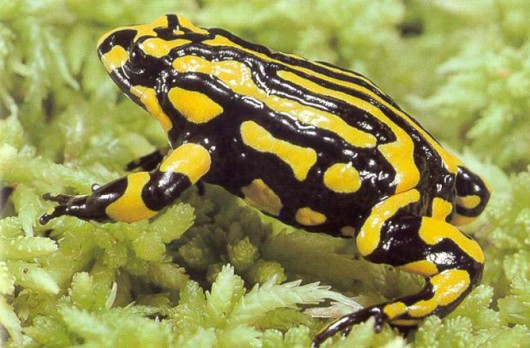 Southern Corroborree Frog (Pseudophryne corroboree)
Endemic to yet critically endangered in the Australian Alps. Southern Corroborree Frog (Pseudophryne corroboree)
Endemic to yet critically endangered in the Australian Alps.
Its demise has been directly caused by habitat destruction from recreational 4WD use, development of ski resorts,
introduced feral animals and human degradation of the frogs’ habitat.
As of June 2004 it was estimated to have a population of just 64.
.
Submission #82 by BirdLife Australia
.
Australia’s leading independent conservation advocate for native birds and their habitats, BirdLife Australia, has its own Threatened Species Committee. In its submission to the review, BirdLife Australia called on Australia’s national environment law, the EPBC Act, to:
.
-
Be accountable
-
Be transparent
-
Deliver on our international commitments
-
Specify measurable ecological outcomes
-
Have a mandate to intervene on matters that are national in scope
-
Be resourced and enforced
-
Give the Australian Community a voice on national environmental matters
-
Be based on independent advice
.
Specifically these were its recommendations in detail:
.
Be accountable
.
a. The Act should require that national environmental accounts are developed (Recommendation 67), produced annually, and include Matters of National Environmental Significance (MNES). Within this the IUCN Red List Index could be used to provide a measure of performance in the threatened species protection and management.
b. The Act should establish an Independent Environment Commission to provide objective, science-based advice to the Minister to improve decision-making and ensure greater transparency and accountability (Recommendation 71). The Commission should be responsible for independent monitoring, audit, compliance and enforcement activities under the Act.
c. The Act should prescribe mandatory decision-making criteria for ecological outcomes (Recommendation 43). All actions should be legally required to maintain or improve ecological outcomes, or to demonstrate a net improvement in national environmental accounts (for each relevant MNES).
d. Regional Forest Agreements require an independent review and a more rigorous approach to auditing. A process for public input and sanctions for serious non-compliance are required. The full protections of the Act should apply to forest activities where the terms of the RFAs are not being met (Recommendation 38).
.
Be transparent
.
a. Transparency in decision-making must be maintained and improved. Current proposals do not go far enough, for example statements of reasons for all decisions made by the Minister and delegates under the Act should be released at time of the decision (Recommendation 44(1)(c)).
b. The Act must provide greater access to the courts for public interest litigation. The Government’s Rejection of Recommendations 48-53 is a key failure of the Government’s response to provide suitable checks and balances for proposals to “streamline” processes.
c. A core element of Hawke’s reform package was to provide for environmental performance audits and inquiries. The Australian Government should be subject to regular environmental performance audit under a new specialist Environmental Performance Audit Unit in the Australian National Audit Office, provided for under the Auditor-General Act 1997.
.
Deliver on our international commitments
.
a. Critical habitat must be protected, with impacts on critical habitat equated to impact on species, and consideration given to the critical habitat required under climate change (Recommendation 12 (1)). However we feel that the critical habitat register should be retained and its remit expanded.
b. The Environment Minister requires powers to develop and implement management plans to protect the values of World Heritage properties, National Heritage Places and Ramsar wetlands where the collaborative processes have not produced effective plans (Recommendation 34).
.
Specify measurable ecological outcomes
.
a. The Act should specify required ecological outcomes. This could be delivered through specified reporting periods for MNES, such as on Species Recovery Plans and Threat Abatement Plans to ensure accountability. The Government agreed the Act should include provisions that enable the auditing of environmental outcomes (performance audits) (Recommendation 61).
.
Have a mandate to intervene on matters that are national in scope
.
a. The primary object of the Act should be ‘to protect the environment’ (Recommendation 3).
b. The Act, and the way it is administered, needs to better reflect the principles of Ecological Sustainable Development (Recommendation 2).
c. The process proposed in the Government response for listing ecosystems of national significance under the Act is too restrictive and inflexible.
d. The National Reserve System should be included as a MNES.
.
Be resourced and enforced
.
a. Cost recovery mechanisms under the Act are needed to ensure that the Environment Department is adequately resourced to ensure operation of the Act and monitor performance (Recommendation 62).
b. A Reparation fund should be established (Recommendation 60). Give the Australian Community a voice on national environmental matters
a. We strongly support the creation of a call in power for ‘plans, policies and programs’ that may have a significant impact on a MNES to better deal with cumulative impacts.
.
Be based on independent advice
a. The quality of Environmental Impact Assessment (EIA) information needs to be substantially improved. An industry Code of Conduct for consultants supplying information for EIA and approval under the Act should be developed and the Minister, or the Environment Commission, should audit assessment information (including protected matters) to test assertions made in EIAs (Recommendation 24).
b. The Environment Commission should also be tasked with establishing a process to free consultants from their commercial dependency on proponents.
.
[Source: ‘Submission to the Australian Senate Standing Committees on Environment and Communications entitled ‘The effectiveness of threatened species and ecological communities’ protection in Australia’, 20130308, by Professor Stephen Garnett(Coordinator – BirdLife Australia’s Threatened Species Committee) and Samantha Vine (Head of Conservation – BirdLife Australia, ^http://birdlife.org.au/].
.
 Margaret River burrowing crayfish (Engaewa pseudoreducta)
[© Photo by Quinton Burham]
With only two known populations, the Margaret River burrowing crayfish is highly endangered.
Even one of these may no longer exist, as there have been no sightings since 1985.
The threats are almost all attributed to human activity.
Land clearing is the biggest danger, as crayfish habitat can be eroded or contaminated by farming, mining and urban development.
Feral pigs also damage habitat.
[Source: ^http://www.australiangeographic.com.au/journal/australias-most-endangered-species.htm] Margaret River burrowing crayfish (Engaewa pseudoreducta)
[© Photo by Quinton Burham]
With only two known populations, the Margaret River burrowing crayfish is highly endangered.
Even one of these may no longer exist, as there have been no sightings since 1985.
The threats are almost all attributed to human activity.
Land clearing is the biggest danger, as crayfish habitat can be eroded or contaminated by farming, mining and urban development.
Feral pigs also damage habitat.
[Source: ^http://www.australiangeographic.com.au/journal/australias-most-endangered-species.htm]
.
Submission #85 by our regular contributors
.
<<We acknowledge the Indigenous Nations of Australia as the traditional owners of its land and waters. We thank them for the ecological wisdom they did and continue to pass to us.
We have read and agree with the contents of the two submissions to the Committee from Marie-Louise Sarjeant, Chris Sarjeant, Sonia Hutchinson, John Marsh and Maxine Jacobson, and from Wendy Radford for BDEC, Stuart Fraser for BFNC and Sara Hill and wish to take this opportunity to register with the Committee our endorsement of them.
.
Introduction
.
<<When about 50 years ago we became involved in environmental issues, we never thought that we will be witnessing in our lifetime the degree of environmental degradation we are witnessing now.
The rate at which the degradation is now occurring is very alarming, as given that global warming and loss of biodiversity exacerbate each other, there is a real possibility that unless we act now, this positive feedback cycle will escalate beyond our ability to prevent it from resulting in the collapse of our life supporting natural ecosystems.
Over the last 20 years that we lived on a property in the forest near Bendigo we personally witnessed the progressive local extinction of the swamp wallaby due to road kills, loss of habitat to development, degradation of the Greater National Park due to fuel reduction burns and weed infestation, including invasive plants escaping from ornamental gardens, replacement of native trees in Bendigo’s streetscapes with exotics and escalation of a thriving population of Indian mynas – and all this, in spite of the biodiversity strategies, environmental protection legislations and scores of submissions, Panel and VCAT hearings.
Why is it then that we are failing to provide effective protection to our biodiversity?
In this submission we will list some of the reasons for this failure.
.
Evidence of the ineffectiveness of threatened species and ecological communities’ protection in Australia
.
The ineffectiveness of threatened species and ecological communities’ protection is evident from the Natural Heritage Trust’s “Australian Terrestrial Biodiversity Assessment 2002” report and from the successive “State of the Environment” reports which show that all the important environmental indicators are getting worse.
The reasons for this ineffectiveness is:
.
Promotion of populations growth
.
Concerns about the unsustainability of population growth and its impact on the natural environment is very well documented (Bartlett 1998, Catton 1982, Lowe 2005, p 59, Suzuki2010, pp 20 and 21) and yet population growth continues to be supported and promoted by politicians (Creighton 2012) and business, while the wide spread misconceptions about it still persist without effective challenge (Lowe 2012).
.
We submit that the Committee recommends that an ecological limit to population growth is determined and implemented into our policy and decision processes
.
Failure to recognize the role apex, or top-order, predators play in the conservation of Australia’s biodiversity
.
The failure by Euro-Australians to recognize the apex terrestrial predators function in sustaining a balance of species that is viable in the long term and in keeping the numbers down of introduced feral species, has and continues to contribute to the decline of Australia’s biodiversity and adversely affects the effectiveness of threatened species and ecological communities protection.
In the case of the avian apex predator, the Wedge-tail Eagle (Aquila audax), the recognition and acceptance of its value to the environment and to farmers took number of years after CSRIO published its research results in the second half of last century.
Unfortunately, in the case of the mammalian apex predator, the dingo (Canis lupus dingo), until recent years “dingoes have rarely been studied to reach a larger understanding of our place in the Australian environment. Dingoes have mainly been studied so humans can maximize the efficacy of control efforts, capitalize on available resources and increase short-term economic gain” (Purcell 2010, p. 117), with the obvious consequent enforcement of people’s misconceptions and detrimental treatment of the dingo.
The adverse effects of the current management under the Fraser Island Dingo Management Strategy as detailed in Marie-Louise Sarjeant et al Submission of 23-11-12 to this Committee and of the mainland controls, especially by aerial baiting (Bullen 2012, Purcell 2010, p. p 3, 116, 137) on the dingo population and its culture as well as on livestock, show the urgency with which the current research (De Bias 2009, Johnson et al 2007, Purcell 2010, Wallach and O’Neill 2008, Brook et al 2012, Wallach and Johnson) needs to be taken seriously, supported by funding and implemented.
We stress here that unlike domestic dogs, cats and foxes that breed twice a year, dingoes breed only once a year, like wolfs do, are self- regulating (Purcell 2010, pp 10 and 113) and do not breed during droughts (Purcell 2010, p 24); they form small packs with hierarchical structure with only the alpha pair reproducing. The alpha pair teaches its offsprings about the packs territory and what and how to hunt, especially how to hunt kangaroos. These characteristics and not its coat colour, skull shape or genetic “purity” makes the dingo so important to Australia’s ecology (Purcell 2010, pp 39, 40, 101). Our disturbing its pack structure and culture is what causes the problem (Purcell 2010, pp3, 116,137). After all, the dingoes coexisted with Aboriginal people for thousands of years without being a problem to humans or ecology. Because their diet consists mainly of kangaroos and rabbits and not as popularly believed livestock (Purcell 2010, p 50), dingoes, like wedge-tailed eagles, are also beneficial to farmers.
We therefore submit that the Committee recommends that in order to improve the effectiveness of threatened species protection, management of key threats to listed species and of Species Recovery Rlans, the dingo needs to be reclassified as protected. New research should be funded and its findings implemented into management and a Species Recovery Plan.
We also submit that, given the Indigenous Peoples’ knowledge of the dingo, its role as the apex predator, the interdependence of species and the importance of maintaining balance (Parker 2007, Rose 1987, Rose 2000, Rose 2011), the Committee recommends that the object 3(2)(9)(iii) of the EPBCA 1999 be taken seriously and Indigenous Peoples’ role in and knowledge of the dingo and its part in the conservation of biodiversity be implemented into the management of the conservation of species and ecological communities.
.
Failure to address our cultural maladaptations, especially our culture of exuberance
.
“The culture of exuberance seemed to impute almost supernatural capabilities to Homo sapiens. It prevented us from seeing that the process of “creating our own habitat” might be a trap, the technology might come to enlarge our resource appetites instead of our world’s carrying capacity” (Catton 1982, p 122).
In the new branch of the study of human ecology, cultural maladaptation is defined as those cultural delusions, i.e. ideas and assumptions that are sheer nonsense, lending to behaviours which are equally nonsensical, which result in activities that cause a great deal of unnecessary human distress, or undesirable damage to ecosystems, or both (Boyden 2004).
Our society’s most deeply entrenched cultural maladaptation is the delusion that “humanity is apart and above natural world and in command of inexhaustible resources”. (Christie 1993)
This cultural maladaptation, or culture of exuberance, which was reinforced by our colonial expansions, technological innovations in food production, harvesting of oceans and access to minerals became the basis of our economy and as such is now fiercely defended and promoted by main stream economists, businessmen and politicians (Catton 1982) making our society more and more dependent on finite resources and responsible for the current unprecedented biodiversity crisis we now find ourselves in.
We submit that the Committee recommends that in order to make it possible to improve the effectiveness of the protection of biodiversity, this cultural maladaptation needs to be urgently addressed as “men who continue to perceive our predicament according to a pre-ecological paradigm simply will not recognize limits imposed by our world’s finiteness” (Catton 1982, p 31).
We further submit that the Committee recommends the development of a program to raise community’s awareness about both the fundamental truth, namely that “the economy is a subset of human society which, in turn, is part of the environment” (ASE 1996, p 5), as well as about the new ecological paradigm (Catton 1998, p 238), so that the most important reason for conserving biodiversity and protecting our natural environment is understood and implemented into our decision processes.
.
The dominance of economy in our decision-making processes
.
“In the short term, of course, financial considerations dominate national decision making. But behind the financial transactions there are real physical processes whose effects accumulate over long periods, and lead to serious environmental problems”. (Cocks 1996/97)
Section 3A(a) of EPBC Act 1999, provides that “decision-making processes should effectively integrate both long-term and short term economic, environmental, social and equitable considerations.”
The fundamental truth that we, the human species, are part of and therefore dependent on the environment while economy is of our making and so is part of our society and therefore dependent on both us and the environment, implies that environment needs to be given priority in our decision-making processes or alternatively, the decision-making processes need to be made subject to environmental constrains dictated by ecological sciences in the same way as they are made subject to constraints dictated by physics.
Yet the reality is that economy still continues to play dominant part in our decision-making processes. If this were the case with physics, then our buildings, houses etc would be collapsing and aeroplanes falling from the sky.
We therefore submit that the Committee recommends that in order to ensure the effectiveness of the protection of biodiversity, the decision-making processes should be given priority to the environment over economy and that such justification as “triple bottom line” and “achievement of balance” are no longer relevant in decision-making processes as the environmental bottom line has been already breached long time ago and the achievement of balance breaches it even more each time it is applied.
.
The emphasis on threatened species and ecological communities in the protection of biodiversity
.
It is now well documented that the conservation of biodiversity including threatened species and ecological communities’ protection, depends on the extent of functioning ecosystems and the ecological connectivity such as biolinks, between them (Tepper 1893, Archer 1993, Milburn 1996, Recher 1999). Yet in spite of the fact that we have cleared and fragmented the native vegetation beyond their ability to sustain their biodiversity, we place emphasis on the protection of threatened species and ecological communities while still continue to issue permits to exploit and clear land for various non-ecological purposes and economic gains.
In Victoria, we even found a way to get around the Victoria’s Biodiversity Strategy’s objective for management of biodiversity goal of ensuring that within Victoria “there is a reversal, across the entire landscape, of the long-term decline in the extent and quality of native vegetation, leading to a net gain with the target being no loss by the end 2001”, by inventing the habitat-hectare measure and designing an offsetting system which, in the case of medium and higher quality of native vegetation can be shown by simple mathematics to always lead when applied to net loss of the native vegetation’s extent.
We therefore submit that the Committee recommends that in order to improve the effectiveness of threatened species and ecological communities’ protection, Prof Harry Recher’s recommended most urgent actions to “end the clearing of native vegetation, reduce grazing pressure, remove inappropriate fire regimes, control feral and native animals whose abundance threatens native species, and restore functional ecosystems, with emphasis on native vegetation, to a minimum of 30% of the landscape” be implemented (Recher 1999) and the restored ecosystems be interconnected by restoring effective biolinks.
The ending of the clearing of native vegetation is very important as it is easier to restore the habitats when remnants are present than when the land is cleared. Also the remnats provide habitat for fauna while restoration is in progress.>>
.
Conclusion
.
When we are healthy, we tend to be unaware of the presence of our organs in our bodies and of the functions they perform. Only when one of our organs fails and we have to replace its functions by artificial means do we become aware of how valuable and well performed its function was.
It seems to us that our attitude to the natural environment is the same as it is to our bodies. The air conditioner, water purifiers and desalination plants should make us aware of the value of the services our natural ecosystems provide us with (Constanza et al 1997 estimated the value of world’s ecosystem services as being more than double the global gross national product, remarking that in a sense it is infinite, as without it the economy would grind to a halt). Yet somehow we fail or refuse to see the connection. The danger is that when eventually we wake up to it, it will be too late to stop the consequences of our abuse of the environment.
It is for this reason that we have included the issue of cultural maladaptation in our submission.
Because a number of important issues, including those relating specifically to the Fraser Island’s dingo and to Bendigo region as well to the ecological reasons for rejecting COAG’s proposal for handing Federal Government’s responsibility for environmental approval to the states are covered in the two submissions to the Committee we are endorsing, we have decided not to duplicate them in our submission.
Finally we would like to draw the Committee’s attention to two books, “Legacy”(Suzuki 2010) and “Resetting the Compass”(Yencken and Wilkinson 2000, in particular chapter 13, “The four pillars of wisdom”), as they explain in a very comprehensive way the issues we have raised in our submission.>>
.
References
.
1. Alexander, N. 2009 – “Concerns heightening for Fraser Island Dingoes”; Ecos 151, Oct.-Nov., 2009, pp 18-19
2. ASE 1996 – “Australia, State of the Environment”, Executive Summery, 23 May.
3. Archer, M. Prof. 1993 – in “Expert says national parks will make mammals extinct” by Tania Ewing; The Age, 5-11-1993, p 4. (note that the title is misleading, it should be “national parks are not large enough to prevent by themselves mammal extinctions”).
4. Bartlett, A.A. 1998 – “Reflections on sustainability, Population Growth and the Environment – revisited”; www.iclahr.com/bartlett/reflections.htm
5. Boyden, S. 2004 – “The Biology of Civilization”; Ockham’s Razor, 12 December
6. Brook, L.A., Johnson, Ch.N. and Richie, E.G. 2012 – “Effects of predator control on behaviour of an apex predator and indirect consequences for mesopredator suppression”; Journal of Applied Ecology, 49: 1278-1286
7. Catton, W.R.Jr. 1982 – “Overshoot, the Ecological Basis of Revolutionary Change”; University of Illinois Press
8. Christie, M.J. Dr. 1993 – “Aboriginal Science for Ecological Sustainable Future”; Australian Teachers Journal, March, no 68
9. Cocks, D. Dr. 1996/97 – in “Making tracks for the future”; Ecos 90, Summer, p 14
10. Constanza, R. et al 1997 – “The value of the world’s ecosystem services and natural capital”; Nature, vol. 387, 15 May, pp 253 to 260
11. Creighton, A. 2012 – “People mean Growth: Turnbull”; The Australian, 3 November
12. De Blas, A. 2009 – “The Dingo’s role revitalized”; Ecos 147, Feb.-March, 2009, pp12,13;
13. Johnson, Ch. N., Isaac, J. L. and Fisher, D. O. 2007 – “Rarity of top predator triggers continent-wide collapse of mammal prey: dingoes and marsupials in Australia”; Proceedings the Royal Society, B, Biological Science (2007) 274, 341-348;
14. Lowe, I. 2005 – “A Big Fix; radical solutions for Australia’s environmental crisis”; Black Inc
15. Lowe, I. 2012 – “Australia’s population debate”; Ockham’s Razor, 19 August
16. Lowe, I. 2012 – “Bigger or Better – Australia’s Population Debate”; Uni. Of Queensland Press
17. Milburn, C. 1996 – “Native daisy sowing seeds of destruction”; The Age 11 of March
18. O’Neill, A. 2002 – “Living with the Dingo”; Envirobook ;
19. Parker, M.A. 2007 – “Bringing the Dingo Home: Discursive Representation of the Dingo by Aboriginal, Colonial and Contemporary Australians”; PhD Thesis, University of Tasmania
20. Parkhurst, J. 2010 “Vanishing Icon: the Fraser Island Dingo”; Grey Thrush Publishing;
21. Purcell, B. 2010 “Dingo”; CSIRO Publishing;
22. Rose, D.B. 1987 – “Consciousness and Responsibility in an Aboriginal Religion”; Chapter 15 in Edwards, W.H. “Traditional Aboriginal Society, a Reader”; McMillan
23. Rose, D.B. 2000 – “Dingo Makes us Human, Life and Land in an Australian Aboriginal Culture”; Cambridge Uni. Press
24. Rose, D. B. 2011 “Wild Dog Dreaming, Love and Extinction”; University of Virginia Press;
25. Suzuki, D. 2010 – “The Legacy, an Elder’s Vision for our Sustainable Future”; Allen & Unwin
26. Wallach, A. and O’Neill, A. 2008 – “Persistence of Endangered Species: Is the Dingo the Key?” Report for DEH Wildlife Conservation Fund;
27. Yencken, D. & Wilkinson, D. 2000 – “Resetting the Compass: Australia’s Journey Towards Sustainability”; CSRIO Publishing.
.
~ Submitted by Stanislaw Pelczynski and Barbara Pelczynska
.
.
“There is something fundamentally wrong with treating the earth as if it were a business in liquidation.”
~ Herman Daly
.
Tags: Australia's Critically Endangered Mammals, Australia's Ecology, Australia's Threatened Fauna, Babyboomer Middle-Aged Men, Bridled Nailtail Wallaby, Christmas Island Pipistrelle, critically endangered, demographic drivers of ecological destruction, ecopolitical spin, Environment Minister, Environment Protection and Biodiversity Conservation Act 1999, EPBC Act Review, Gilbert's Potoroo, Government Ecological Hypocrisy, Great Barrier Reef, Key Threatening Processes, Orange-bellied Parrot, Peter Garrett, Senate Committee, Species Recovery Plans, Threat Abatement Plans, Threatened Species, Threatened Species Scientific Committee, Tony Burke, TSSC, wildlife extinctions
Posted in Threats from Weak Environmental Laws | 2 Comments »
Add this post to Del.icio.us - Digg
Friday, June 22nd, 2012
 Green Sea Turtle (Chelonia mydas)
Also known as Green Turtle, Black (sea) Turtle, or Pacific Green Turtle and can be found on Australia’s Great Barrier Reef.
The species is listed as ‘Endangered‘ by the IUCN and CITES and is protected from exploitation in most countries where it is illegal to collect, harm or kill them. Green Sea Turtle (Chelonia mydas)
Also known as Green Turtle, Black (sea) Turtle, or Pacific Green Turtle and can be found on Australia’s Great Barrier Reef.
The species is listed as ‘Endangered‘ by the IUCN and CITES and is protected from exploitation in most countries where it is illegal to collect, harm or kill them.
.
Australia’s Great Barrier Reef is one of the world’s seven natural wonders. It is the world’s largest reef system stretching over 2,600 kilometres from Lady Elliot Island off Gladstone Harbour up to the top of Cape York Peninsula at the Torres Strait.
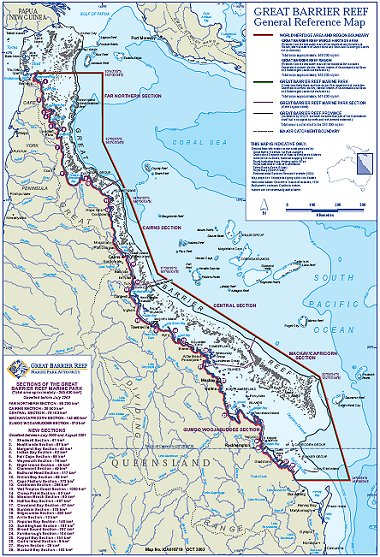
The Great Barrier Reef has 411 types of hard coral, comprises 900 islands and 2,900 individual coral reefs as well as many cays and lagoons . It is a natural sanctuary for 36 species of marine mammals including whales, dolphins and porpoises, some 1500 fish species, 134 species of sharks and rays, 4,000 types of mollusc and is home to 215 species of birds either migrating, nesting or roosting on the islands.
The Reef and associated beaches provide vital habitat home to six species of sea turtles which swim vast distances to the reef to breed including the Green Sea Turtle. Both the Green Sea Turtle and the unusual Dugong are species particularly threatened with extinction due to Aboriginal Poaching and associated non-traditional commercial exploitation.
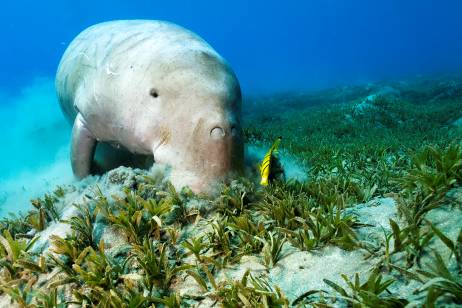 Dugong (Dugong dugon) feeding on Sea Grass Meadows
(Photo by Barry Ingham) Dugong (Dugong dugon) feeding on Sea Grass Meadows
(Photo by Barry Ingham)
.
Dugongs?
.
Dugongs were hunted toward extinction by European colonists during the 19th Century for their meat and oil.
Most Dugongs now live in the northern waters of Australia between Shark Bay and Moreton Bay particularly in the Torres Strait and along the Grest Barrier Reef. Ongoing ‘traditional’ hunting is driving populations close to extinction. Consequently the IUCN lists Dugongs as ‘Vulnerable‘ to extinction, while the CITES limits or bans the trade of derived products.
Australian Aborigines and Torres Strait Islanders ignore this and continue to poach Dugongs for non-traditional commercial exploitation. ^Read about Dugongs
.

In 1981, The Great Barrier Reef was inscribed on the UNESCO’s World Heritage List under all four natural World Heritage criteria for its outstanding universal value:
- Outstanding example representing a major stage of the Earth’s evolutionary history
- Outstanding example representing significant ongoing geological processes, biological evolution and man’s interaction with his natural environment
- Contains unique, rare and superlative natural phenomena, formations and features and areas of exceptional natural beauty
- Provide habitats where populations of rare and endangered species of plants and animals still survive
.
The IUCN-protected Great Barrier Reef Marine Park is 345,000 square kilometres in size; five times the size of Tasmania or larger that the United Kingdom and Ireland combined!
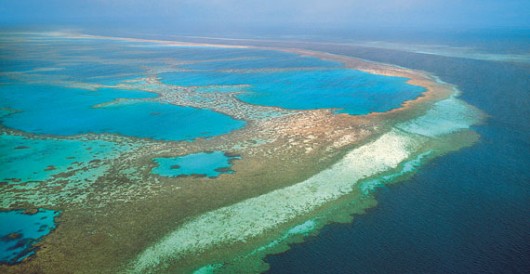
As scientists have become to understand more about the Reef’s complex ecosystem, they have discovered that damaging fishing practices, pollution and coral bleaching exacerbated by increased sea temperatures due to global warming are compounding to jeopardise the Reef’s future.
 . .
The ecological protection and management of the Great Barrier Reef Marine Park is delegated by the IUCN to the safe custody and sovereignty of the Australian Government, currently under the Minister for Sustainability, Environment, Water, Population and Communities, Tony Burke MP. The management task in turn has delegated the responsibility to The Great Barrier Reef Marine Park Authority guided by the Great Barrier Reef Marine Park Act 1975 (Cwlth), which is headquartered in Townsville and with regional offices in Cairns, Mackay, Rockhampton and Canberra.
.
“The Great Barrier Reef is internationally recognised for its outstanding biodiversity. The World Heritage status of the Reef recognises its great diversity of species and habitats. Conserving the Reef’s biodiversity is not just desirable – it is essential. By protecting biodiversity, we are protecting our future and our children’s future.”
~ GBRMPA website
.
Great Barrier Reef Tourism
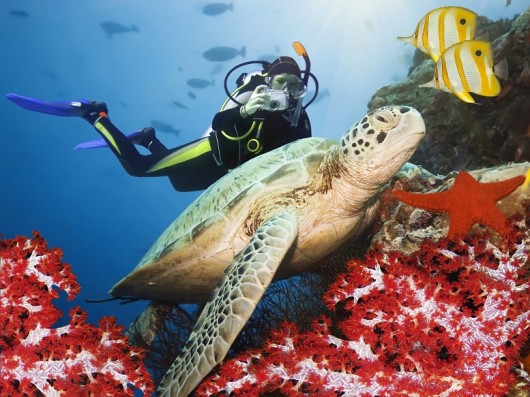 Because of the Reef’s magnificent biodiversity, diving on the Reef is very popular
(Diver with Green Sea Turtle) Because of the Reef’s magnificent biodiversity, diving on the Reef is very popular
(Diver with Green Sea Turtle)
Tourism Australia promotes the Reef thus:
.
‘Once you’ve experienced the Great Barrier Reef you will know why it is one of the seven wonders of the natural world. Diving and snorkelling are a must. Stay at a one of the many heavenly island resorts. Charter a yacht and sail The Whitsundays. Find your own uninhabited island. Where else in the world can you find a beach where the only footprints in the sand are your own.
There are hundreds of dreamy islands and coral atolls on the World Heritage-listed Great Barrier Reef, so take your pick. Luxury lovers and honeymooners will be in heaven on Lizard Island, exclusive Bedarra or privately-owned Double and Haggerstone Islands. For a wilderness experience, bush camp on Fitzroy Island or trek the Thorsborne Trail along mist-cloaked Hinchinbrook Island. Day trip to Green and Fitzroy Islands, snorkel the brilliant coral reefs of the Low Isles or sea kayak around Snapper Island, Hope Islands National Park with an Aboriginal guide. Townsville, Port Douglas and Lucinda are just some of the mainland gateways.’
.
And at the northern tip of the Reef, Cape York and the Torres Strait Islands are promoted thus:
.
‘Sitting just north of Cape York, between Australia and Papua New Guinea, the Torres Strait Islands are made up of 274 small islands, only 17 of which are inhabited. These communities have developed a unique blend of Melanesian and Australian Aboriginal cultures. Get a glimpse with a trip to Thursday or Horn Island, the group’s most developed islands. Learn about the local pearling and fishing industry on Thursday island, reached by ferry from Cape York. Visit the museum, art gallery and historic World War II sites on Horn Island, accessible by flight. Both islands are blessed with pristine beaches, azure waters and vivid fringing reefs supporting dugongs and sea turtles.’
.
[Source: Tourism Australia, a department of the Australian Government, ^http://www.australia.com/about/australias-landscapes/australias-islands.aspx]
.
It all seems like idyllic paradise!
.
..
Australia’s disturbing reality on The Reef and at Cape York
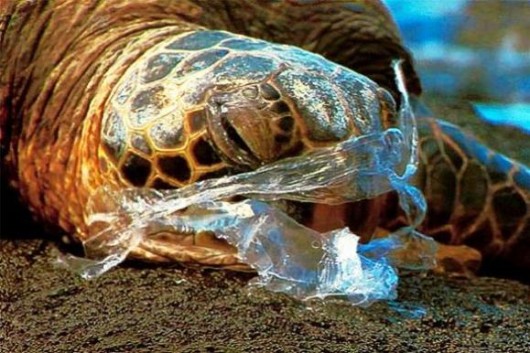
There are thousands of native Sea Turtles dying on our Great Barrier Reef as a result of:
- Water Pollution from sewage and stormwater
- Water pollution and farm pestidices, herbicides and fertilisers
- Damaging Fishing Practices
- Illegal Poaching
- Cyclones and Flooding
- Tredging of Gladstone Harbour and associated coastal Industrial Development
- Bulk Cargo Ships leaking contaminants
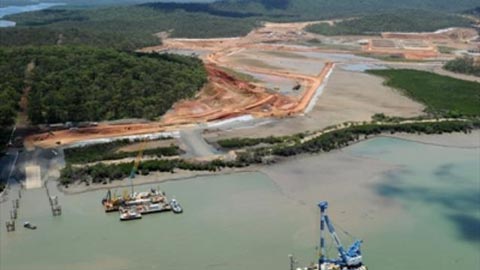
Gladstone Harbour dredging in 2011-12 by the Gladstone Ports Corporation and LNG
..continues to muddy Barrier Reef habitat and destroy Sea Grass Meadows critical to Sea Turtkes and Dungongs
.
The recent Queensland floods and cyclones have starkly shown the impacts of water pollution on the marine environment. Pesticide and mud pollution from out-dated farming practices has led to a massive spike in Dugong and Sea Turtle deaths.
In addition, poor fishing practices can still kill too many of our Sea Turtles and Dugongs, and industrial development is proliferating along the coast and removing remaining habitats, such as Sea Grass Meadows that Sea Turtles and Dugongs depend on for their survival.
Over the past 12 months, more than 1,400 turtles and 180 dugongs have washed up on our beaches. Clearly our Reef is under enormous pressure and our wildlife is suffering.
The Great Barrier Reef is a World Heritage global icon and something that Queenslanders are proud to be the custodians of. It is unacceptable to many of us that the Reef would be under this amount of pressure. We’re not alone in these concerns – UNESCO’s World Heritage Committee also expressed serious concern recently about the long-term health of the Great Barrier Reef.
[Source: ^http://support.wwf.org.au/queensland-turtles.html]
.
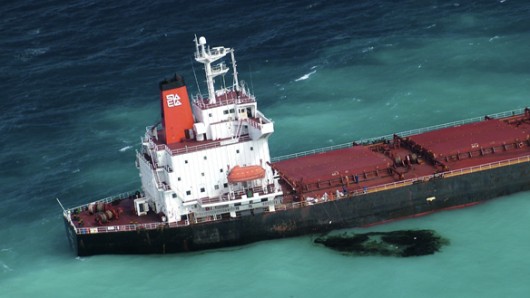 Oil is seen next to the 230-metre bulk coal carrier Shen Neng I about 70 kilometres east of Great Keppel Island, 20100404.
“damage to the reef is significant, with large parts of Douglas Shoal “completely flattened” and marine life “pulverised”.
(Maritime Safety Queensland/Reuters) Oil is seen next to the 230-metre bulk coal carrier Shen Neng I about 70 kilometres east of Great Keppel Island, 20100404.
“damage to the reef is significant, with large parts of Douglas Shoal “completely flattened” and marine life “pulverised”.
(Maritime Safety Queensland/Reuters)
.
‘130 turtles stranded this year‘
.
‘The Scientific Advisory Committee has been charged with the task of investigating this year’s spate of marine animal deaths in Gladstone Harbour.
Responding to calls for all results to be made public, the environment minister’s office provided the following data:
- 130 turtle strandings were reported; 11 of those were released or in rehabilitation
- Of 119 turtles found dead in the harbour this year, only 24 had autopsies conducted
.
Of those 24 turtles, 13 were identified as dying from human activity (11 boat strikes and two undetermined); 11 were identified as dying from natural causes (10 from ill health and disease and one undetermined).
Eight Dugongs have been found dead. One was killed by boat strike and one from netting. The remaining six were too badly decomposed for autopsies.
Five Dolphin deaths were reported. One was caused by unspecified human activity. The remaining four were too decomposed.
Because floods damaged seagrass levels, marine animals are more vulnerable to human activity.’
[Source: ‘130 turtles stranded this year’, 20110824, ^http://www.gladstoneobserver.com.au/story/2011/08/24/130-turtles-stranded-in-harbour-this-year/]
.
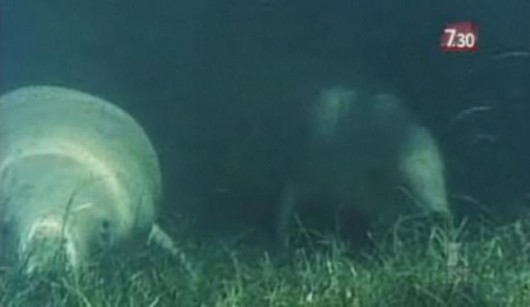 . .
‘Another Dugong death’
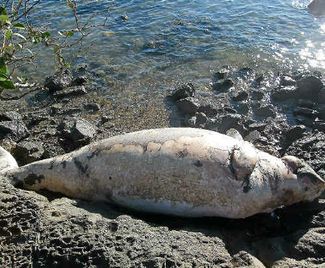 This dead dugong was found on Witt Island by Clive Last (July 2011)
who is increasing worried by marine animal deaths in Gladstone Harbour (Great Barrier Reef). This dead dugong was found on Witt Island by Clive Last (July 2011)
who is increasing worried by marine animal deaths in Gladstone Harbour (Great Barrier Reef).
.
‘Another dead Dugong has been found in Gladstone Harbour, and the man who found it wants some answers.
Clive Last, who in May discovered a dead dolphin on Turtle Island, was shocked on Friday afternoon when he found the body of a dead Dugong on Witt Island.
Mr Last is wary of suggestions marine animal deaths this year can be attributed to boat strikes and net fishing. He said those explanations didn’t match his observations on the harbour.
“I honestly believe it’s either starvation (from damaged seagrass meadows) or there is something in the harbour,” Mr Last said. “Right now, Turtles and Dugongs are continually coming up. That means there is (something) going on.”
He believed the Dolphin he found in May had no injuries to indicate it had been killed by boat strike or fishing nets.
The Department of Environment and Resource Management reported the Dolphin’s body was too decomposed to conduct a necropsy.
Mr Last said, once again, the dead Dugong’s body showed no sign of injury. He took five photos and called Queensland Parks and Wildlife.
Mr Last, whose work requires him to spend a lot of time on the harbour, is increasingly disturbed by the trend of dead marine animals in Gladstone Harbour.
“If I don’t see another one after today, I’ll be very happy,” he said. “I’d also be very happy if someone would come up with the truth about what is really killing them. “You can’t keep saying it’s boat strike, when I’ve got photos showing it’s not boat strike.”
Mr Last said he was worried the scientific advisory committee’s investigation into the deaths in Gladstone Harbour would take too long to come up with results.
DERM (Queensland Department of Environment and Resource Management) could not be contacted over the weekend.
The list goes on:
- The dead Dugong found on Witt Island was the latest in a long, mysterious list of marine animal deaths this year.
- Three dead Dolphins were found in Gladstone Harbour in May, within two weeks of each other.
- The latest discovery is the fourth Dugong found dead in the harbour since May
- More than 40 Turtles have washed up dead in the harbour since April. The Turtle deaths have been the subject of intense debate between environmentalists and commercial fishermen.
- Marine experts from various organisations have told The Observer seagrass levels, damaged by the floods, are putting stress on the animals.
.
“LNG will deliver billions of Australian Dollars to be shipped overseas as profit we will be left with the rotting carcasses of dead dugongs, poisoned water tables, destroyed farmland and a bill for the infrastructure the council builds for them.”
~ Comment by Chris Norman from Agnes Waters (July 2011)
.
[Source: ‘Another dugong death’ by David Sparkes, The Gladstone Observer, 20110725, ^http://www.gladstoneobserver.com.au/story/2011/07/25/another-dugong-death-marine-deaths-gladstone/]
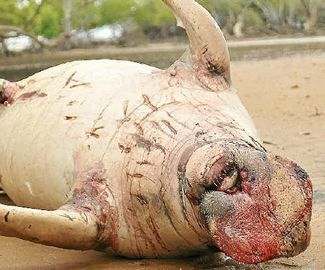 Dugong washed up at Gladstone – marked with gashes Dugong washed up at Gladstone – marked with gashes
.
Heinous cruelty as Aborigines hack live pregnant Green Sea Turtle
.
There’s tension in far north Queensland between Traditional Hunting rights (Ed: read ‘perversion’) and the protection of Turtles and Dugongs, and it is resulting in some horrific treatment of native animals.
Transcript from ABC Broadcast (extracts of video added):
.
CHRIS UHLMANN, PRESENTER: Protected Dugongs and Sea Turtles are being cruelly slaughtered in Queensland’s Torres Strait to supply an illegal meat trade.
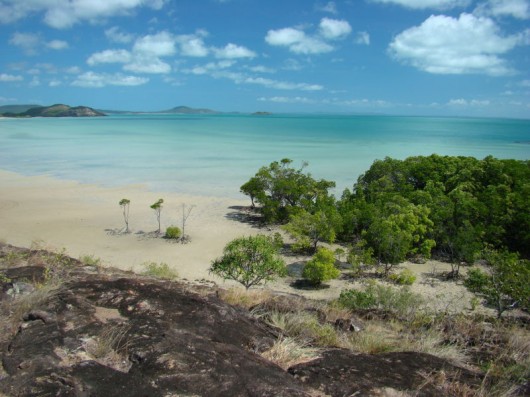 Tranquil coastal tip of Cape York Peninsula and the Torres Strait Tranquil coastal tip of Cape York Peninsula and the Torres Strait
.
An investigation by 7.30 has found deeply confronting footage that we are about to air. It shows the brutal methods used to hunt the animals, with turtles being butchered alive and dugongs drowned as they’re dragged behind boats.
The investigation throws into sharp relief the conflict between Indigenous Australians and animal rights activists over traditional hunting and exposes a black market in animal meat.
And a warning: this report by Sarah Dingle and producer Lesley Robinson contains disturbing images and coarse language.
SARAH DINGLE, REPORTER: At the northern-most tip of Australia lie the serene islands and waters of Queensland’s Torres Strait, the birthplace of Native Title. But on those beaches, there’s a slaughter underway.
7.30 travelled to far North Queensland where IT entrepreneur turned eco warrior Rupert Imhoff has been investigating the fate of threatened turtle and dugong populations. And what he found is shocking. A turtle lies tethered for up to three days, waiting to die.
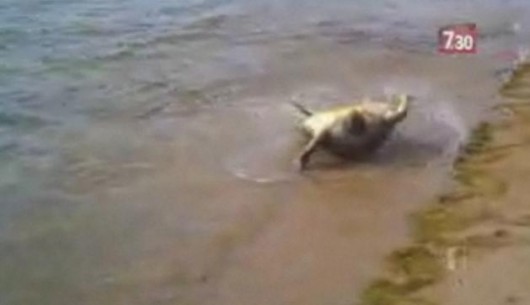 Green Sea Turtles are routinely tethered by rope by local Aboriginal/Torres Strait Islander men in the shallows,
then inverted on to their backs so that they tire from struggling and often drown. Green Sea Turtles are routinely tethered by rope by local Aboriginal/Torres Strait Islander men in the shallows,
then inverted on to their backs so that they tire from struggling and often drown.
.
RUPERT IMHOFF, ECO WARRIOR: They dragged it out of the water, flipped it on its back. You could see it was already terrorised. It was flapping around madly. And they came up with this concrete block and basically tried to slam it in the head, obviously to stun the animal. Didn’t quite work.
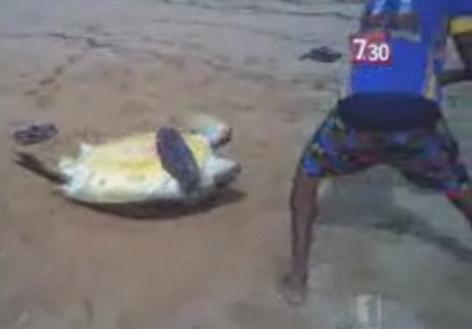 Man uses a concrete block and throws it twice at the Turtles head
but the female Turtle continues to flap. She has no voice. Man uses a concrete block and throws it twice at the Turtles head
but the female Turtle continues to flap. She has no voice.
.
SARAH DINGLE: The images become even more confronting.
RUPERT IMHOFF: Before they started hacking off its fins, they wanted to check if it was pregnant, and sure enough this turtle was a mature aged turtle. Had up to 125 eggs in it. It was gonna be the next generation of turtles, but they decided to cut it up right there and then.
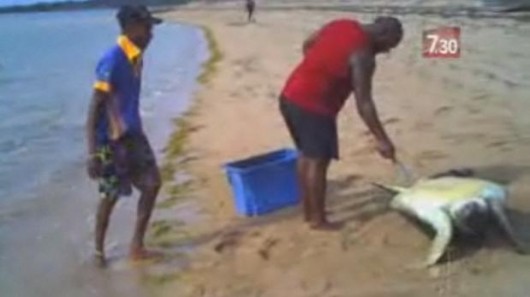 Aboriginal man knifes into the womb of the female Turtle to see it if pregnant
– she is. Aboriginal man knifes into the womb of the female Turtle to see it if pregnant
– she is.
.
SARAH DINGLE: Even as it’s hacked, the turtle clings to life, apparently in agony for seven and a half minutes.
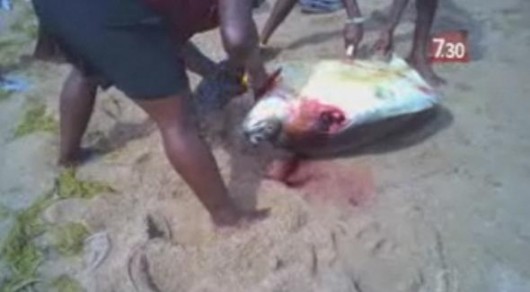 The man then starts hacking into the live healthy Turtle
Left flipper already hacked off, the still live turtle has its right flipper hacked off,
while the men keep it helplessly lying on its back The man then starts hacking into the live healthy Turtle
Left flipper already hacked off, the still live turtle has its right flipper hacked off,
while the men keep it helplessly lying on its back
.
RUPERT IMHOFF: Didn’t actually die until they took off the bottom shell, they actually peeled off the shell and then it just let out one gasp – one last gasp of air and passed away.
SARAH DINGLE: Using a hidden camera, Rupert Imhoff spent two weeks in the Torres Strait filming the hunting of sea turtle and dugong which are both listed as vulnerable to extinction.
RUPERT IMHOFF: They go out, they spear them at sea, they then tie the tail to the back of the boat and they hold the head underwater. And it can take up to seven and a half minutes again, so I’ve been told, for that dugong to drown.
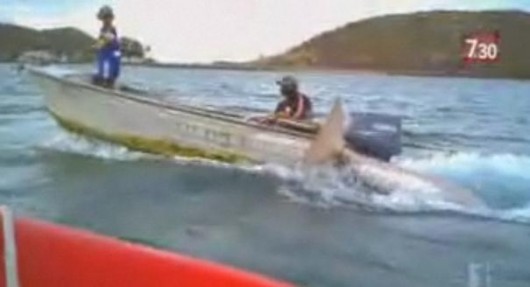 Speared Dugong, still alive is tied by the tail fin to the side of the boat so it drowns as the boat returns to shore Speared Dugong, still alive is tied by the tail fin to the side of the boat so it drowns as the boat returns to shore
.
SARAH DINGLE: Here, a Dugong is methodically carved up for consumption. For anyone else, this kill would be illegal, as dugong are protected under federal law. However, the Native Title Act allows traditional owners to hunt to satisfy their personal, domestic or non-commercial communal needs.
Anywhere in Australia, this horrific cruelty would be will illegal. But in Queensland alone, Native Title hunting is exempt from animal cruelty laws. Animal rights activists are appalled.
Lawyer Rebecca Smith was a paid consultant on the turtle and dugong hunt for the Torres Strait Regional Authority.
REBECCA SMITH, LAWYER: Most conservation groups won’t touch this issue. It’s just too hard, too prickly, too sensitive. It’s often deemed – people who are opposed to traditional hunting are often called racist, but there’s nothing racist about saying, “This is cruel. We’ll move on from there. We’ll do this humanely now. We’ve progressed.”
SARAH DINGLE: Aerial surveys of dugong and turtle numbers are imperfect and no-one knows exactly how many there are. Green sea turtles face an extra pressure. They’re by far the turtle species most intensively hunted for their meat. But locals say there are bigger threats for turtle and dugong.
???: You know we are under threat from pig predation, our – one of the greatest, biggest rookeries in the Southern Hemisphere on Cape York, Rain Island, is under threat from climate change, but we seem to be concentrating I think far too much on, you know, Indigenous people hunting them.
SARAH DINGLE: What is known is that the Great Barrier Reef is a last stronghold. It’s home to the biggest sea turtle rookery in the globe and one of the world’s largest population of dugong.
Cairns-based Colin Riddell calls himself “The Dugong Man”. A former abattoir worker, he’s an unlikely but tireless campaigner for animal rights.
COLIN RIDDELL, ANIMAL RIGHTS CAMPAIGNER: I have to pursue it to the end because otherwise the end may be for the animals.
SARAH DINGLE: Colin Riddell’s investigations have revealed the slaughter goes on far to the south in coastal Queensland waters.
Green Island is one of the jewels in the crown of Cairns tourism. We’ve been told just last week at this spot Indigenous hunters chased down and took a green sea turtle in full view of shocked tourists. There’s no way of knowing where those hunters came from, but locals say this is a weekly occurrence on this island.
STEVE DAVIES, TOUR OPERATOR: They can be out there a lot, you know – three, four, five times a week. They come across in quite large tinnies with large outboard motors on board and they chase the turtles till they’re completely and utterly exhausted.
SARAH DINGLE: The culture clash between hunters and tourists has led to heated confrontations.
INDIGENOUS HUNTER (Amateur video): This our land! We don’t list end to your shit, mate! We can do anything on this land we wanna do, mate!
SARAH DINGLE: This video was shot two weeks ago by a tourist and given to 7.30. It shows an allocation between a tour boat and three Indigenous hunters.
INDIGENOUS HUNTER (Amateur video): Ya just don’t tell us what to do on our land! You’re not from this f***in’ land; we are! We’re the traditional owner! We own every f***in’ reef around here, mate!
SARAH DINGLE: It’s not clear what they’re hunting for, but there’s no mistaking the tensions.
INDIGENOUS HUNTER (Amateur video): You f*** off back to your country. This is my country, c***.
SARAH DINGLE: Is there a sense in your area that the Indigenous hunters are untouchable?
STEVE DAVIES: Without a doubt. And they believe they’re untouchable.
SARAH DINGLE: But there are conservation efforts.
Well away from the glitzy marinas and the tourist strip, here in the industrial area of Cairns is the town’s only turtle rehabilitation centre. It’s run on the smell of an oily rag. Here, injured and starving turtles are treated and brought back to full health.
Today, Jenny Gilbert and her team are readying a 180 kilogram breeding age female green sea turtle for release. By the look of things, this 80-year-old turtle has already survived a number of hazards.
Turtles like this are being hunted not traditionally, but for a very modern purpose. Our investigations have revealed the hunt is feeding a flourishing black market.
JAMES EPONG, MANDUBARRA LAND & SEA CORP.: Well nine times out 10 the illegal trade is to sell the meat for the benefit – for grog money or drugs.
SARAH DINGLE: And can you can make a buck out of it?
JAMES EPONG: Yes. There’s one person that we know of in Yarrabah made $80,000 one year.
SARAH DINGLE: James Epong is a Mandubarra man who lives on his traditional lands an hour south of Cairns and Yarrabah. The Mandubarra have declared a moratorium on taking turtle and dugong from their see country, but around them, the illegal meat trade continues.
JAMES EPONG: I myself went to a pub on a Friday afternoon to go and have a coldie with one of me mates and was approached by some other Indigenous people with trivac (phonetic spelling) meat for sale, which was turtle and dugong.
SARAH DINGLE: On four separate occasions 7.30 has confirmed multiple eskies arriving on the afternoon flight from Horn Island to Cairns.
RUPERT IMHOFF: I do not know 100 per cent for a fact what was in those eskies, but I have heard numerous reports and been told by the islanders themselves that they are transporting an excessive amount of turtle and dugong down to Cairns. Now on my flight I think there was about six or seven eskies that come off and I’ve been told that it almost a daily routine.
SARAH DINGLE: Indigenous sea rangers are employed and equipped by governments to care for marine wildlife. This esky was addressed to a ranger.
RUPERT IMHOFF: From what I understand and what I observed and what I spoke to the islanders about is the head hunters on all these islands are actually the rangers themselves. Now this money has gone into their pockets. It’s gonna help them buy outboard motors and help them basically go and hunt these turtle and dugong down in bigger numbers.
SARAH DINGLE: Were any of the people you saw hunting and killing animals rangers?
RUPERT IMHOFF: Yes, they were 100 per cent.
SARAH DINGLE: Did you pay those people in your footage to do what they were doing?
RUPERT IMHOFF: We did not pay a single person any money while we were up there.
SARAH DINGLE: And the illegal trade continues further south.
SEITH FOURMILE, CAIRNS TRADITIONAL OWNER: I know that there’s a lot of non-Indigenous people that are doing it as well.
SARAH DINGLE: Are they doing the hunting or are they involved in other way?
SEITH FOURMILE: They’re involved with the trading of it, or selling it and passing it down, and some of the turtle meats has gone far down as Sydney and Melbourne.
SARAH DINGLE: And it’s not just dugong and turtle meat being sold. Traditional owners from Cape York are pushing to end the indiscriminate slaughter and stop the esky trade.
 Sea Turtle air freighted from Cairns to Sydney and Melbourne
Nothing to do with ‘Traditional Hunting’, which is a low-life smokescreen for what it really is:
Illegal Wildlife Poaching and Trade for personal commercial profit. Sea Turtle air freighted from Cairns to Sydney and Melbourne
Nothing to do with ‘Traditional Hunting’, which is a low-life smokescreen for what it really is:
Illegal Wildlife Poaching and Trade for personal commercial profit.
.
FRANKIE DEEMAL, TURTLE AND DUGONG TASKFORCE: We don’t have that kind of legislative assistance to do that. What do you do when you confront a rogue killer?
SARAH DINGLE: And we’ve heard a lotta people talk about rogue killers. Who are these rogue killers?
FRANKIE DEEMAL: They’re there.
SARAH DINGLE: Who are they?
FRANKIE DEEMAL: They know who they are.
SARAH DINGLE: For those with Native Title rights, customs can change.
LOCAL MAN: We’re gonna name this turtle Bumbida (phonetic spelling), after our grandmother.
SARAH DINGLE: But the Mandubarra people at least have sworn to protect these animals.
CHRIS UHLMANN: Sarah Dingle with that report, produced by Lesley Robinson.
And 7.30 contacted the Queensland Department of Environment and Resource Management. In a statement it said it takes, “the claims very seriously and will investigate all reports of illegal hunting and poaching”.
You can follow the progress of the turtles released in this story by going to the sea turtle satellite tracking page.
Editor’s note: (April 16) the ABC also approached the Torres Strait Regional Authority (TSRA) several times over the course of a week prior to broadcast but their spokesperson was unavailable for comment.
Watch the entire Documentary aired nationally across Australia in March 2012:
WARNING: THIS VIDEO CONTAINS DISTURBING ANIMAL CRUELTY WHICH MAY OFFEND. WE INCLUDE IT TO PORTRAY THE REALITY OF AUSTRALIA’S TREATMENT OF TURTLES AND DUGONGS IN THE NAME OF ‘TRADITIONAL HUNTING’

[Source: ‘Hunting rights hide horror for dugongs, turtles’, by reporters Sarah Dingle and Lesley Robinson, documentary presented by Chris Uhlmann, 730 Programme, 20120308, Australian Broadcasting Corporation, ^http://www.abc.net.au/7.30/content/2012/s3448943.htm]
.
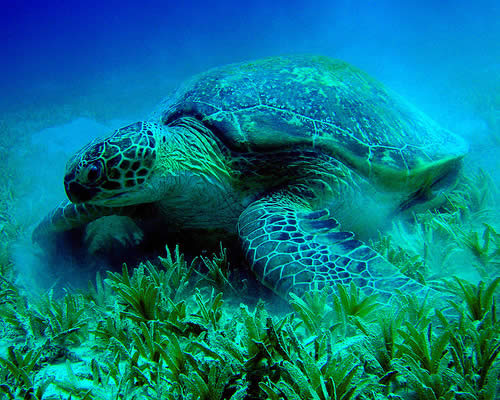
.
‘Queensland to outlaw Dugong-hunt cruelty’
.
Animal activists have welcomed moves by the Queensland Government to outlaw hunting-related cruelty to dugongs and turtles.
.
‘Under the Native Title Act, traditional owners are allowed to hunt Turtles and Dugongs.’
.
Footage aired on the ABC in March showed animals being butchered alive by some Indigenous hunters and sparked an investigation into the practice.
Queensland Fisheries Minister John McVeigh yesterday introduced legislation into Parliament to outlaw any unreasonable pain being inflicted during hunting.
The RSPCA’s Michael Beatty says the Government should be commended.
“No-one thinks – including the Indigenous leaders – that this type of cruelty, if you like, is necessary,” he said.
Mr Beatty says authorities need to continue to work with traditional owners. “It isn’t simply a case of just outlawing it, it really isn’t that simple because obviously it has to be policed as well,” he said.
But animal activist Colin Riddell says the hunting should be banned altogether. “People flock to Australia to see our Great Barrier Reef and see those beautiful animals and I fear for the day that my children, your children don’t get to see those animals,” he said.
Native title hunting rights would not be extinguished by the Bill.’
[Source: ‘Queensland to outlaw dugong-hunt cruelty’, 20120620, ABC, ^http://www.abc.net.au/news/2012-06-20/animal-rights-groups-welcome-cruelty-hunting-ban/4080688]
.
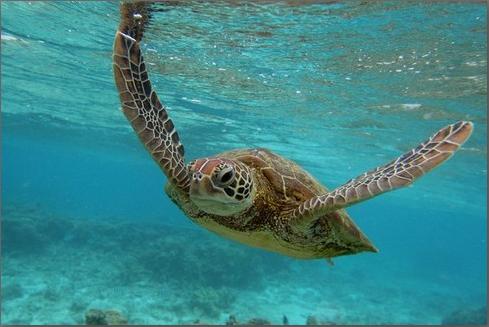
But this heinous cruelty by Indigenous Australians has long been know by the Australian Government..
.
Back in 2011: ‘Call for inquiry into marine animal poaching‘
.
The Federal Opposition has called for a judicial inquiry into Dugong and Turtle poaching in far north Queensland. Tourism operators say tourists have been exposed to mutilated and slaughtered turtles on island beaches, off Cairns. Four far north Queensland Liberal National Party (LNP) candidates say they want that stopped at key tourism sites.
Pictures of a mutilated turtle found on Green Island by tourists at the weekend have prompted public outrage. The animals are legally protected but the Native Title Act allows for hunting by traditional owners.
But Federal Opposition environment spokesman Greg Hunt says legal hunting is not the problem.
“The advice we have from Indigenous leaders is that the vast bulk of hunting is poaching,” he said. Mr Hunt says inaction on poaching is causing problems.
“There really has to be a crackdown on poaching,” he said. “The vast bulk of the take of Turtle and Dugong is coming from poaching. “There is a trade in illegally obtained meat and animal product. “This is a complete breach of the law.”
The Great Barrier Reef Marine Park Authority is investigating the issue.
[Source: ‘Call for inquiry into marine animal poaching‘, by Brad Ryan, ABC, 20111107, ^http://www.abc.net.au/news/2011-11-11/call-for-inquiry-into-marine-animal-poaching/3660324]
.
Back in 2010: ‘Cairns Turtle and Dugong activist campaigns against slaughter caught on video’
.
Former union activist turned environmental defender Colin Ridell, who counts Bob Irwin, John Mackenzie, Derryn Hinch and Greg Hunt MP among his loyal following, says the silence is deafening from the government to stop slaughter of turtles on the waters around Cairns.
Riddell is campaigning to reduce the taking of turtle and dugong, that is occurring under the protection of Native Title, until a complete scientific study is done to determine the actual numbers to be taken.
“It will be tightly controlled by the EPA and the elders with a permit system, that is monitored by special investigators. I and other indigenous elders support a moratorium to determine the take,” Riddell says. “The skulls of each to be kept to determine actual permitted numbers taken, as is done in other permit systems.”
He says that any breach would carry a substantial penalty, however advocates a complete ban in green zones, like all our coastal tourist areas. “I don’t want international tourists and interstate visitors to take home horror stories.”
The campaign follows the leaking of a graphic video showing a turtle having its flippers hacked off while still alive. RSPCA Queensland has called for a review of traditional hunting.
“It’s just not good enough, this is a violent and obscene way to treat these animals, ” Cairns resident Colin Riddell told CairnsBlog. “Any indigenous person is allowed to kill sea turtles and dugongs for weddings or funerals, but it has far beyond that, and is being commercially moved around the state.
“I don’t want international tourists and interstate visitors to take back horror stories home,” he says Riddell, who has taken his campaign to every State and Federal Government minister.
“I’ve written to the Minister for Local Government and Aboriginal and Torres Strait Islander Partnerships who have acknowledged my letter,” Riddell says. “The replied thanking me for me letter and said it ‘will be actioned as appropriate.’ However I have received no response,” he says.
Riddell has also wrote to Greg Combet for support, who he engaged with as a Manufacturing Workers Union site convener at the Australian Defence Industries Benalla plant. He says that Environment Minister Peter Garrett has also given him the “bum’s rush.”
“I received a response from the ‘Parliamentary Clearance Officer’ however it was totally unsatisfactory,” Riddell said. “I told them to get my message Peter Garrett, which was a direct result of Jim Turnour’s and Peter Garrett staffers. Weak efforts.”
Another response from the International Whaling Commission fell on deaf ears. “I asked them why we condemn Japan when Australians do the same,” Colin Riddell said. Julie Creek, responded. “Your message was deleted without being read.”
The original poster of the graphic video says that it’s fair enough if you have to kill turtles because it is a “traditional right” but who cuts the leg of a cow first and let it die in its own blood?
“No one is going to starve in Australia because we stop the killing of turtles. Australia earns millions of dollars with the tourism industry – with tourists who come to dive with turtles and in the same country we torture the turtles to death,” the anonymous poster wrote. “Species will vanish forever and in the end it does not matter whose fault it was. This is not a question of human races this is a question of respect and ethics towards other creatures.”
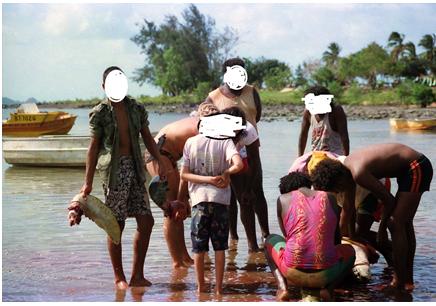
Colin Riddell and the RSPCA are trying to track down who shot the video and where it was taken, so they can investigate the incident. It is believed it was filmed in North Queensland mid last year.
.
“Until now cruelty to animals using traditional hunting methods has been put in the too hard basket by governments.”
.
Mark Townend of the RSPCA said. “Far from it, he said. We have Aboriginal and Torres Strait Island elders who support us on this issue.
.
“Hunting from tinnies with rifles is not traditional.”
.
“We’re committed to ensuring that any breaches of the Animal Care and Protection Act are fully investigated while at the same time taking into consideration traditional hunting rights,” RSPCA chief inspector Michael Pecic says. “We can’t do this alone. We’re a charity and yet it appears we’re the only organisation that is taking this matter seriously.”
“We have Aboriginal and Torres Strait Island elders who support us on this issue,” Riddell says. “Hunting from tinnies with rifles is not traditional. Leaving turtles and dugongs to be butchered alive and left to die on the beach is not traditional. We’re not attacking the indigenous community. This is simply not an appropriate way to kill these animals.”
James Epong, son of an aboriginal elder says that Ma:mu traditional owners have a right to hunt for protected species such as dugong and marine turtles that is recognised by Australian Law.
“Our Ma:mu traditional owners, who are also called the Mandubarra mob, have put aside some of these rights and signed a Traditional Use Marine Resource Agreement so they can protect rather that exploit dugong and marine turtles,” James Epong says.
The agreement for their turtle business is co-ordinated through the Mandubarra Land and Sea Corporation and was finalised in June 2008.
“I am very proud to see that Ma:mu traditional owners are prepared to sacrifice rights and traditions, for the sake of helping threatened turtle and dugong stocks recover,” Epong says. “Keep in mind the Ma:mu people are setting aside hunting and cultural practices that go back tens of thousands of years for the future benefit of all Australians.”
In 1996, a landmark High Court decision concerned with particular pastoral titles, was passed regarding Native Title hunting rights. The decision did not allow anyone simply to claim Indigenous links and then hunt and kill native animals anywhere in Queensland. It authorised any legitimate native title holder to hunt and kill for genuine sustenance and other needs and without first obtaining a licence, but only in areas over which native title is held by that group.
The decision did not allow native title owners to trap or kill wildlife for commercial purposes, however Colin Riddell says that this is occurring. “These area being transported through the Cairns Airport in Eskys,” he says.
Riddell says on his website that the 1996 decision says nothing one way or the other about using modern weapons like guns and powered boats to undertake traditional hunting. It is interesting that the use of harpoons, outboard-powered boats, and steel axes to kill the crocodiles as an exercise of native title hunting rights.
“It seemed to concern nobody on the High Court bench, with the possible exception of Justice Callinan. Followers of native title developments need to keep in mind the distinction between exercising an established native right in a modern way, as in the Yanner case, and the loss or abandonment of traditional and established native title rights themselves, as found by the trial judge to be a fatal flaw in the Yorta Yorta decision.”
.
Commercial Exploitation of Hunting and Fishing Rights
This issue, namely the extent to which the holders of native title may exercise the relevant rights in a “modern” fashion, and indeed the connected issue of whether they might even commercially exploit those rights, are difficult ones. Whilst not directly in issue in the Yanner case, these issues are of considerable importance in the broader scheme of Australian native title law – and are yet to be answered conclusively.
Some important developments in this area are taking place in Canada. In the Supreme Court of Canada’s 1997 decision in Delgamuukw v British Columbia, the majority judges noted that, while the rights of Indigenous title holders in that jurisdiction are not limited to engagement in activities which are aspects of practices, customs, and traditions integral to the claimant group’s distinctive Indigenous culture, lands held by Aboriginal title cannot be used in a manner that is irreconcilable with the nature of the claimants’ attachment to those lands.
So, for example, tribal hunting areas may not be “strip mined” or, so it would seem, “hunted out” or “fished out” in a large-scale commercial operation. Contrast this with small-scale trading between local Indigenous people and others, for which there is some historical and anthropological evidence in Australia and elsewhere.
There are important legal differences between the doctrines of Aboriginal title in Canada and Australia, but there are also some important similarities which indicate that these Canadian developments might in the future be of relevance in Australia. Of course, it is also important in Australia to note that the Commonwealth Native Title Act moderates but does not destroy the capacity of the States and Territories to regulate the exercise of native title rights along with other rights, as in fishing, conservation, and safety legislation which might apply equally to Indigenous and non-Indigenous people alike.
“Jim Turnour says this is a racial issue,” Colin Riddell says. “You know, I’m disgruntled as well. You know what I do. I tell you what, I’m begging people to vote for Warren Entsch in and get rid of Jimmy,” he says.
See the shocking video here…
WARNING: THIS VIDEO CONTAINS DISTURBING ANIMAL CRUELTY WHICH MAY OFFEND. WE INCLUDE IT TO PORTRAY THE REALITY OF AUSTRALIA’S TREATMENT OF TURTLES AND DUGONGS IN THE NAME OF ‘TRADITIONAL HUNTING’

[Source: ‘Cairns turtle and dugong activist campaigns against slaughter caught on video’, by Michael Moore’s Cairns.blog.net, 20100410, ^http://www.cairnsblog.net/2010/04/cairns-turtle-and-dugong-activist.html]
.
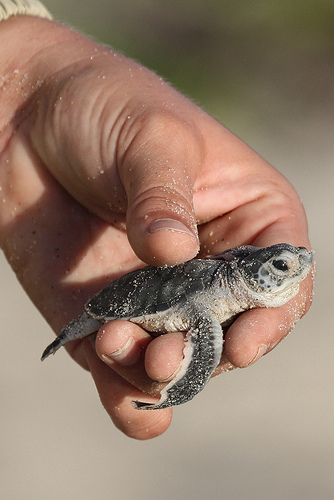 A species completely at our mercy A species completely at our mercy
.
Ed:
- The Great Barrier Reef Marine Park Authority has been aware, so is complicit, immoral, incompetent and so entire Board should now be immediately sacked, and any government employee (rangers or otherwise found to have been in anyway involved with the killing of Dungongs or Turtles or trading in their body parts.
- The killing of Dungongs or Turtles in Australia is to be immediately policed and investigated jointly by the Australian Government, whatever the causes of the deaths
- The Australian Government needs to amend Australia’s Native Title Act 1993 and Australian Crimes Act 1914 to make any cruelty toward any wildlife in Australia and its territories a criminal act under Australian Crimes Act. Traditional Hunting that involves cruelty is to be outlawed. It is Commercial Exploitation of Traditional Hunting and Fishing Rights.
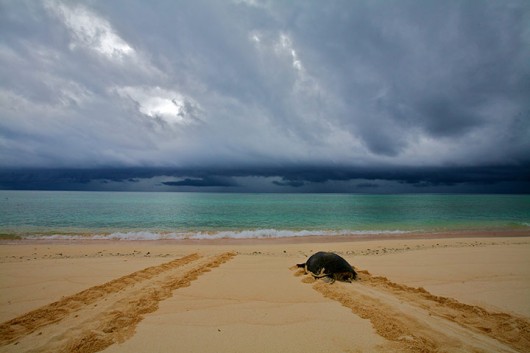 An horrific life, a bleak future An horrific life, a bleak future
It is 2012
.
References and Further Reading
.
[1] The Great Barrier Reef inscription on the UNESCO’s World Heritage List, ^ http://whc.unesco.org/en/list/154
.
[2] Australian Goverenment ^ http://www.environment.gov.au/heritage/places/world/great-barrier-reef/values.html
.
[3] Great Barrier Reef ^ http://www.greatbarrierreef.org/great-barrier-reef-facts.php
.
[4] The Great Barrier Reef Marine Park Authority ^ http://www.gbrmpa.gov.au/
.
[5] ‘ Three kilometres of Great Barrier Reef damage, 20 years to mend‘, by Tom Arup, The Age newspaper, 20100414, ^ http://www.theage.com.au/environment/three-kilometres-of-great-barrier-reef-damage-20-years-to-mend-20100413-s7p8.html
“It could take 20 years or more for the Great Barrier Reef to recover from three kilometres of destruction caused by the grounding of a Chinese coal ship, authorities have revealed. The Great Barrier Reef Marine Park Authority says the damage to the reef is significant, with large parts of Douglas Shoal “completely flattened” and marine life “pulverised”.
.
[6] ‘ WWF Welcomes investigation into marine wildlife deaths‘, World Wildlife Fund, 2011, ^ http://awsassets.wwf.org.au/downloads/pr252_wwf_welcomes_investigation_into_marine_wildlife_deaths_17jun11.pdf [> Read Media Release] – that was last year.
.
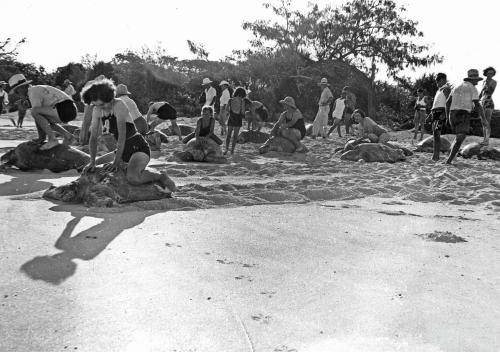 Australians Turtle Riding on Heron Island
Great Barrier Reef, 1938
[Source: © Queensland historical Atlas, ^http://www.qhatlas.com.au/category/keywords/great-barrier-reef] Australians Turtle Riding on Heron Island
Great Barrier Reef, 1938
[Source: © Queensland historical Atlas, ^http://www.qhatlas.com.au/category/keywords/great-barrier-reef]
.
Tags: Aboriginal Poaching, animal cruelty, animal welfare, Australia, Cape York, Cape York Peninsula, cites, Delgamuukw v British Columbia, Dugong, Gladstone Harbour, Great Barrier Reef, Great Barrier Reef Marine Park, Great Barrier Reef Marine Park Act 1975, Great Barrier Reef Tourism, Green Island, Green Sea Turtle, hacking holidays, Indigenous Culture, iucn, Lady Elliot Island, Queensland Holidays, Scientific Advisory Committee, Sea Grass Meadows, Shen Neng I, The Great Barrier Reef Marine Park Authority, Traditional Hunting Perversion, UNESCO's World Heritage Committee
Posted in Cape York (AU), Dugongs, Marine Wildlife, Threats from Fishing | 1 Comment »
Add this post to Del.icio.us - Digg
Wednesday, March 21st, 2012
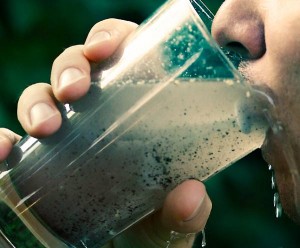 When Coal Seam Gas fracking contaminates underground aquifers When Coal Seam Gas fracking contaminates underground aquifers
.
Since 2008, Anna Bligh’s Queensland Labor Government has encouraged and welcomed the establishment of Coal Seam Gas (CSG) across Queensland with open arms…
“The Queensland Government welcomes the establishment of a new energy industry, which diversifies our State’s fuel mix and capitalises on our state’s extensive coal seam gas (CSG) reserves to meet the growing global demand for liquefied natural gas (LNG). The LNG industry provides Queensland with an exciting opportunity to create new jobs in our regional centres, affected by the recent downturn in resource exports, and increases the potential prosperity of all Queenslanders through greater export revenue and royalty payments.”
[Source: ^http://www.industry.qld.gov.au/documents/LNG/Blueprint_for_Queenslands_LNG_Industry.pdf [>Read LNG Blueprint]
.
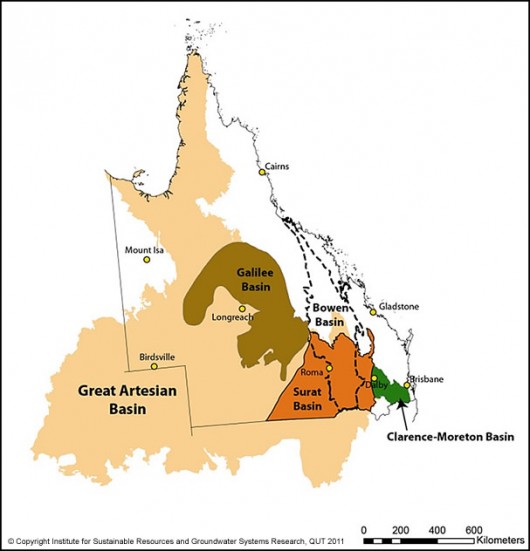 Coal Seal Gas mining permeating across Queensland food bowl
and taking water from our precious Artesian Basin Coal Seal Gas mining permeating across Queensland food bowl
and taking water from our precious Artesian Basin
.
Geoscience Australia:
.
‘Coal Seam Gas (CSG) is a naturally occurring methane gas found in most coal seams and is similar to conventional natural gas. In Australia the commercial production of CSG commenced in 1996 in the Bowen Basin, Queensland. Since then production has increased rapidly, particularly during the first decade of the 21st century. CSG has now become an integral part of the gas industry in eastern Australia, particularly in Queensland.
Information about reserves of CSG has grown significantly, particularly in the Bowen and Surat basins in Queensland. In New South Wales reserves have been proven in the Sydney, Gunnedah, Clarence-Moreton and Gloucester basins. Exploration has been undertaken or is planned to be undertaken in other coal basins including the Galilee, Arckaringa, Perth and Pedirka basins.
A major driver for the growth in CSG was a decision in 2000 by the Queensland Government that required 13% of all power supplied to the state electricity grid to be generated by gas by 2005. That requirement has been increased to 15% by 2010 and 18% by 2020.
CSG reserves have grown to such an extent that a number of Liquid Natural Gas (LNG) plants have been proposed based on exports from Gladstone, Queensland.’
[Source: Geoscience Australia, ^http://www.ga.gov.au/energy/petroleum-resources/coal-seam-gas.html]
.
The grossly financial wasteful Labor Government in Queensland has become so desperate for new revenue that the promised millions in CGS royalties from this new LNG industry is tantalisingly irresistable to the extent that Queensland farms and environment have become deliberately ignored and railroaded by the Bligh Labor Government.
Bligh’s Labor Government has wasted:
- $2 billion on the Toowoomba water recycling plant, now a white elephant
- $1.1 billion on another rusting desalination plant at Tugun
- $600 million on the failed Traveston Dam plan
- $450 million on the Traveston Crossing plan
- $350 million on Wyaralong Dam, not even connected to the grid
- $283.5 million on the health payroill debacle
- $112 million on Smart Card drivers licenses that aren’t smart
- $7 million a month in government advertising
- $450,000 rental bill for an empty State Government office in Los Angeles
.
[Ed: This is criminally negligent misappropriation of the entrusted Queensland Treasury]
[Source: ^http://www.stoplaborwaste.com/]
.
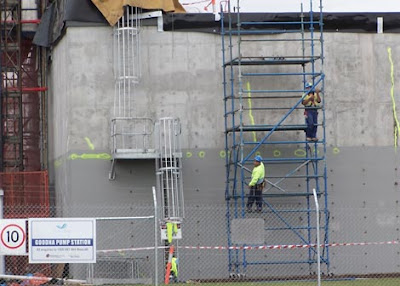 Goodna Sewage Pump Station (outer Brisbane)
designed to convert to drinking water to Toowoomba
..except Toowoomba residents won’t take city shit Goodna Sewage Pump Station (outer Brisbane)
designed to convert to drinking water to Toowoomba
..except Toowoomba residents won’t take city shit
.
So with $5 billion in Queenslander taxes squandered by Queensland Labor, no wonder the Bligh Labor Government has been so desperate for the lure of mining royalties.. at any cost including jeopardising the prime agricultural land of the Darling Downs.
The development of energy resources in the Surat Basin (Darling Downs and South West Queensland region) and associated LNG projects in the Gladstone (Fitzroy and Central West Queensland) region is set provide annual royalty returns of over $850 million to the Bligh Labor Government. Bligh is more than happy to send in the corporate miners to undermine the food bowl of Queenslanders and pollute their drinking water by fracking in the process.
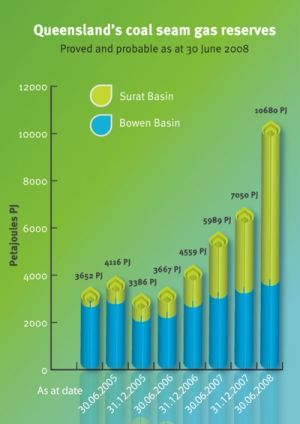
As the above LNG Blueprint disloses above, it is all about ” greater export revenue and royalty payments.”…at any cost – social, heritage, environmental. Queensland Labor Premier Anna Bligh has prrepared to take on the Federal Government over any increase to red tape from its new oversight of the coal seam gas industry.
[Source: ‘Queensland Premier Anna Bligh offers coal seam gas industry help on red tape’, by John McCarthy, The Courier-Mail, 20111123, ^http://www.couriermail.com.au/news/bligh-offers-csg-help/story-e6freon6-1226203063565]
.
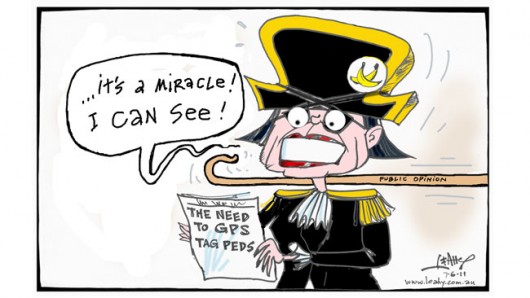 Bligh – new CSG cash royalties
.. fracking Queensland in the process Bligh – new CSG cash royalties
.. fracking Queensland in the process
.
Federal Labor’s Environment Minister Tony Mr Burke has said that Queensland farmers are safeguarded by federal regulations that went much further than those of Queensland.
But in November 2011, confidential advice obtained by The Australian newspaper under Freedom of Information laws, shows that Tony Burke has known about coal-seam gas developments in southern Queensland have serious uncertainties about the impact on groundwater and salinity.
The documents include departmental briefings for Mr Burke’s decision to approve the APLNG project, a joint venture between Origin and Conoco Phillips that involves 10,000 production wells and more than 10,000km of access roads and pipelines.
It is the biggest CSG project ever approved in Australia.
 Tara (west of Dalby), south east Queensland
Coal Seam Gas pipelines now dominate the rural landscape
Tara (west of Dalby), south east Queensland
Coal Seam Gas pipelines now dominate the rural landscape
.
On the groundwater impact, the advice says Geoscience Australia warned of “high levels of uncertainty in the predicted impacts of CSG developments on groundwater behaviour and on EPBC (Environment Protection and Biodiversity Conservation Act) listed ecological communities”. It says that Geoscience Australia believed that “APLNG’s modelling requires further work to fully establish uncertainties”.
The advice to Mr Burke provided in February recommended he approve the $35 billion project because he had approved two smaller projects. This indicates the department has ignored the cumulative effects of these projects on groundwater and water use.
[Read More: ‘Tony Burke warned of ‘uncertain’ gas impact on groundwater‘, by Paul Cleary, The Australian, 20111107, ^http://www.theaustralian.com.au/national-affairs/burke-warned-of-uncertain-gas-impact/story-fn59niix-1226187080366]
.
Bligh’s Labor Mates in Canberra
.
14th March, 2012:
‘Federal Environment Minister Tony Burke (Ed: Labor Party) has removed a possible electoral problem for the Bligh government in Queensland by delaying environmental approval for the massive expansion of the Abbot Point coal terminal in north Queensland until well after the election.
The Queensland government plans to expand Abbot Point, near Bowen and directly beside the Great Barrier Reef, from its current capacity of 50 million tonnes of coal a year to 400 million tonnes, but the Environmental Impact Statement (EIS) for the expansion needs to be approved by the federal government first. The EIS was lodged in December and there is a statutory requirement for the federal minister to respond within 40 working days.
Last week, Mr Burke quietly slipped through an extension of the timeframe until the end of this year, although a hand-written note on the briefing paper written by him states that “I note the decision may still be made earlier than the extended deadline”.
The expansion of Abbot Point is particularly sensitive as the port is right beside the Great Barrier Reef. It is designed to cater for the new coalmining area in the Galilee Basin.
Concerns about possible damage to the reef through a build-up of coal ships passing through the reef have been highlighted in recent days by a visit from UNESCO officers.
Mr Burke’s decision will delay the construction of 12 coal-loading berths at the terminal that have been allocated to six companies, including Waratah Coal, owned by billionaire Clive Palmer.’
.
[Read More: ‘Sensitive Reef coal port decision off agenda‘, by Andrew Fraser, The Australian, 20120314, ^http://www.theaustralian.com.au/national-affairs/elections/sensitive-reef-coal-port-decision-off-agenda/story-fnbsqt8f-1226298622984]
.
Coal Seam Gas kills American cattle
.
Meanwhile, exposure to coal seam gas drilling operations in the United States has been strongly linked to serious health problems in humans, pets, livestock and other animals, a new US study has found. Australian environmentalists say the study shows the need for caution in opening the country up to coal seam gas extraction.
University of Massachusetts researchers interviewed 24 US farmers affected by shale gas drilling and found the practice was “strongly implicated” in serious health problems in humans and animals. In one case, 17 cows died in one hour from respiratory failure after shale gas fracking fluids were accidentally released into an adjacent paddock.
Fracking refers to the controversial method of injecting chemicals, water and sand at high pressures to crack rock and release gas.
On another farm, 70 of 140 cattle exposed to wastewater from fracking died, as did a number of cats and dogs from a neighbourhood where wastewater was spread on roads as a method of disposal.
The study also cites a case in which a child was hospitalised with arsenic poisoning soon after drilling and fracking began near their home. Occupants of another home near gas wells suffered headaches, nosebleeds and rashes, and their hearing and sense of smell was affected.
The study’s authors recommend more research into the effects of shale gas extraction in the US, or a total ban on the practice.
NSW Greens MP Jeremy Buckingham says the study shows the need for caution in the expansion of CSG mining in the state.
“Many of the methods, chemicals and techniques used in US conventional and unconventional gas extraction are the same as those used in Australia with coal seam gas,” he said in a statement.
The National Toxics Network called on Australia’s state governments to conduct a full assessment of the impacts of CSG on animals living close to gas wells.
“We know so little about the long term impacts on the health of wildlife and farm animals of this industry,” the network’s senior adviser Mariann Lloyd-Smith said in a statement.
.
[Source: ‘Study warns of CSG health risks‘, AAP, The West Australian, 20120110,^http://au.news.yahoo.com/thewest/business/a/-/business/12542344/study-warns-of-csg-health-risks/]
.
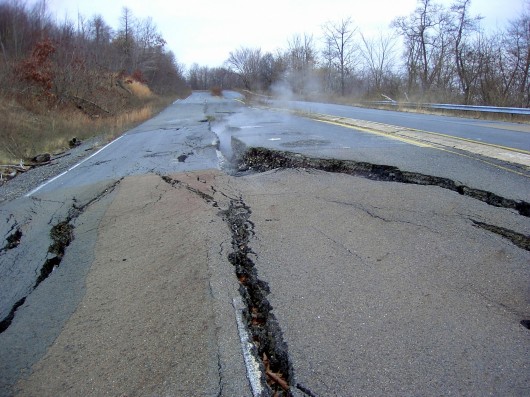 ‘Centralia’, Pennsylvania (USA) and its 1000 residents the victims of a coal seam mine fire in 1962,which has been burning under the area ever since.
The entire town was condemned in 1992 and only a few stragglers are left behind. ‘Centralia’, Pennsylvania (USA) and its 1000 residents the victims of a coal seam mine fire in 1962,which has been burning under the area ever since.
The entire town was condemned in 1992 and only a few stragglers are left behind.
.
Coal Seam Gas poisons cattle in Pennsylvania
.
‘Stillborn and deformed cows, ponds that turned black and poisoned drinking water. Those are some of the little-reported effects being visited on Pennsylvania in the rush to tap natural gas from the Marcellus Shale, two angry Washington County farmers told about 100 people at a forum in Lancaster city Sunday afternoon.
“This has been nothing but hell for my family and neighbors,” said Ron Gulla, whose farm near Hickory was the second Marcellus Shale well drilled in the state….’
.
[Read More: ‘2 farmers assail gas drillers at forum‘, 20110515, LancasterOnline.com, ^http://coalseamgasnews.org/2011/2-farmers-assail-gas-drillers-at-forum/]
.
Back in Queensland, on 30th May 2011, Labor Prime Minister Julia Gillard, and Queensland Labor Premier Anna Bligh unveil the coal seam gas expansion plant at Curtis Island
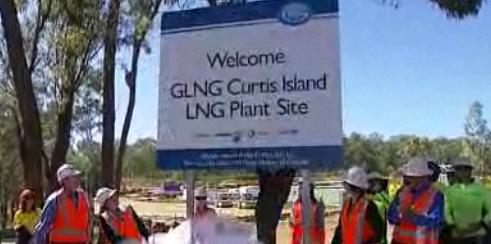 ‘New Gas Age’ for Queensland – enthusiastically opened by Bligh ‘New Gas Age’ for Queensland – enthusiastically opened by Bligh
Goodbye beautiful innocent Gladstone
.
‘Premier Anna Bligh and Prime Minister Julia Gillard herald the ‘new gas age’ as a liquefied natural gas (LNG) storage plant opens Curtis Island off Gladstone in central Qld.’
[Watch ABC Video: ‘Gillard, Bligh unveil coal seam gas expansion‘, ABC TV, ^http://www.abc.net.au/news/2011-05-27/gillard-bligh-unveil-coal-seam-gas-expansion/2734636]
.
Three months later in August 2011, Bligh’s Queensland Government was forced to investige traces of cancer-causing Benzene, toluene and xylene at Arrow Energy’s 14 CSG bores at Tipton West and Daandine gas fields near Dalby.
Benzene, toluene, ethylene and xylene (commonly known as BTEX) were outlawed last October in Queensland for use in fracking, a process used in the CSG industry to split rock seams and extract methane.
.
[Source: ‘Carcinogens found in water at coal seam gas site‘, by Kym Agius, 20110829, ^http://www.brisbanetimes.com.au/queensland/carcinogens-found-in-water-at-coal-seam-gas-site-20110829-1jgxb.html]
.
Queensland Conservation Community (QCC) on Coal Seam Gas
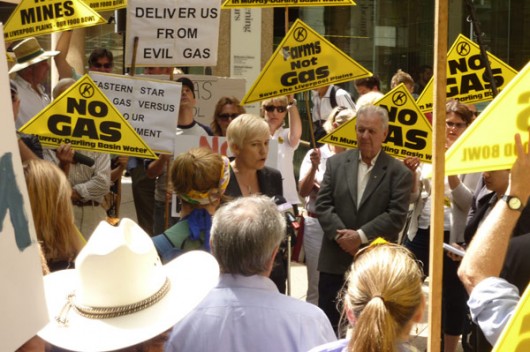
.
Expansion of the QLD Coal Seam Gas (CSG) industry has been occurring at a very rapid rate over recent years.
While the CSG industry is bringing wealth and jobs to areas like the Surat Basin, the immediate and longterm environmental impacts potentially caused by the industry are largely unmeasured and unchecked. This is mainly due to the rapid growth of the industry outstripping legislative and regulatory frameworks, resulting in an imbalance between the CSG industries, primary production and protecting the environment.
.
Key issues
.
The key environmental issues that QCC is concerned about include:
- Impacts to over and under lying aquifers
- Extraction of substantial volumes of groundwater as part of the CSG extraction process is likely to have a significant impact on over and under lying aquifers, which are connected to coal measures from where gas is extracted.
- Independent scientific assessment must determine that potential impacts to adjacent aquifers can be avoided and managed before CSG projects are approved.
.
Groundwater contamination
The quality of groundwater in coal seams is generally inferior to that in over- and underlying aquifers. There is a high risk that poorer quality coal seam water will leak into better quality aquifers from the large number of proposed gas wells and poor well management practices.
There is also a high risk of groundwater contamination caused by hydraulic fracturing, an industry process used to stimulate gas flows by using chemicals and applied at high pressures to fracture the coal seams.
.
Many of the chemicals used to fracture the coal seams are toxic and are known to affect human and environmental health.
- Independent scientific assessment must determine that inter aquifer contamination can be avoided and managed before CSG projects are approved
- Hydraulic fracturing must not occur until robust scientific assessment has demonstrated that groundwater contamination can be avoided.
.
Impacts to springs and groundwater dependent ecosystems (GDE)
The scale of potential long-term adverse environmental impacts to springs and groundwater dependent ecosystems caused by CSG extraction is largely unmeasured.
- Impacts to springs and GDE’s must be avoided. Independent scientific assessment must determine that potential impacts to springs and GDE’s can be avoided and remediated if impacts do occur.
- Protecting springs should be achieved by establishing set back distances around springs where CSG activities are prohibited.
- Using CSG water for beneficial purposes
.
While the Government has introduced regulations requiring CSG companies to treat CSG associated water to ‘fit for purpose’ standards, the potential environmental impacts that could occur from using treated CSG water for different purposes has not yet been fully assessed. The environmental impacts that could occur from using treated CSG water for beneficial purposes includes potential changes to soils chemistry, structure and biota; as well as water quality changes in waterways in areas where CSG water is used.
- CSG water used for a beneficial purpose must match the background environmental water quality conditions of areas where it is being used.
- Using waterways to distribute CSG water
CSG companies are seeking to release treated CSG water to rivers to distribute this water to areas where it will be used for beneficial purposes. As waterways in areas where CSG development is occurring are mostly ephemeral, introducing large volumes of CSG water year round to these waterways will change them from being ephemeral to permanently flowing. This will substantially alter the ecological composition and water quality of waterways, which will potentially cause significant adverse impacts to these aquatic environments. For these reasons, QCC does not support CSG water being introduced to river systems.
- CSG water should not be allowed to enter or be introduced to waterways
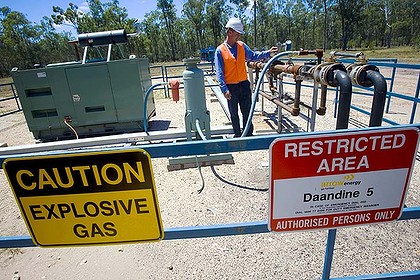
Disposal of salt and other contaminants
It is estimated that millions of tonnes of salt and other toxic substances will be produced from CSG operations. Under current arrangements CSG companies can hold untreated CSG water and brine effluent from reverse osmosis water treatment plants in storage ponds, and then dispose of this waste in a variety of ways.
.
Allowable disposal methods include:
- Creating useable and saleable products,
- Burying residual solid wastes on properties owned by CSG companies or
- By injecting the brine effluent into aquifers with a lesser water quality.
QCC does not support CSG companies being allowed to bury salt on their properties or injecting brine effluent underground due to the inherent environmental risks associated with these disposal methods. A more environmentally safe disposal method that QCC favours is to require CSG companies to rapidly dehydrate the brine effluent using waste heat generated from water treatment power plants; and then either marketing the residual solid waste or burying it in regulated hazardous substance landfill sites.
.
- Injection of brine effluent into aquifers should not be permitted
- Residual solid waste from CSG water treatment processes should only be disposed into registered hazardous substance landfill sites
- Avoiding good quality agricultural land
The CSG industry is seeking to expand into some of Queensland’s prime agricultural areas. The is likely to effect food and fibre production from impacts to groundwater resources that primary producers depend on.
Along with the impacts to groundwater, it is increasingly evident that the number of roadways, pipelines, brine storage dams and other necessary CSG infrastructure will have a significant impact on farming activities and operations.
- CSG exploration and development must be prohibited on good quality agricultural lands
.
Avoiding areas of High Ecological Significance (HES)
.
Under current legislative arrangements, the only tenure of land that is exempt from CSG exploration and development are National Parks. This means that important areas of High Ecological Significance outside of National Parks, such as wetlands, springs, biodiversity corridors and threatened ecological communities, can be degraded by CSG exploration
and development.
Although CSG companies are required to offset environmental impacts, it is unlikely that the full extent of environmental impacts caused by the expansion of the CSG industry as a whole can be effectively offset. This will result in an overall net loss of environmental values throughout the areas where CSG development occurs. That must not be allowed to occur.
.
- CSG exploration and development must be prohibited in areas of HES such as wetlands, springs, biodiversity corridors and threatened ecological communities
- Strategic re-injection of CSG water Estimates indicate that up towards 350,000Ml of groundwater per year could be extracted from coal seams as part of the gas production process.
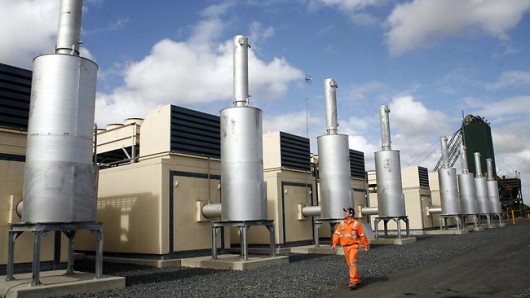
There are significant concerns about the impacts that may occur to other aquifers that are connected to these coal seams. An effective way to mitigate impacts to over- and underlying aquifers is by strategically re-injecting treated CSG water either back into coal seams or into effected adjacent aquifers.
- Treated CSG water should be re-injected back into coal seams from where it has been extracted or into adjacent aquifers that have been affected by CSG operations
- Moratorium on CSG development
Many of the environmental issues associated with the CSG industry have yet to be satisfactorily addressed. QCC believes that a precautionary approach is needed and is calling for a moratorium to be placed on CSG projects until robust scientific assessment has determined that environmental impacts occurring from CSG operations can be avoided, mitigated and the industry can be managed sustainably.
.
- moratorium should be placed on CSG development until scientific assessment can demonstrate that environmental impacts can be avoided and mitigated
.
[Source: Queensland Conservation Community (QCC), 20101001, ^http://qccqld.org.au/docs/Campaigns/SaveWater/CSG%20Position%20Paper.pdf, >Read Paper 160 kb]
.
Threats by Coal Seam Gas to Australia’s Artesian Basin
.
‘The Australian Petroleum Production and Exploration Association acknowledge that CSG extraction has potential to deplete or contaminate local aquifers.
There are many of these in the northern Illawarra that recharge streams, creeks, lakes and dams in the water catchments and coastal plain.
The National Water Commission estimate that the Australian CSG industry will extract around 7,500 gigalitres (GL) of produced water from ground water systems over the next 25 years. To put this in perspective, that’s more than 13 times the capacity of Sydney Harbour. They also note that the potential impacts of CSG development on water systems, particularly the cumulative effects of multiple projects, are not well understood….’
.
[Source: ^http://stop-csg-illawarra.org/csg-risks/threats-to-water/]
.
The coal seam gas industry is facing a rural revolt, with farmers threatening to risk arrest and lock their gates to drilling companies.
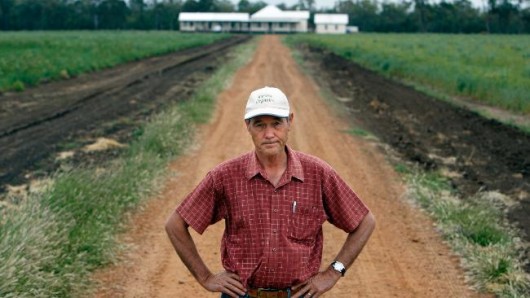 Organic farmer, Graham Back, at his property west of Dalby, southern Queensland
He won’t be rolling out the red carpet for drilling companies
[Photo: Cathy Finch Source: The Courier-Mail]
[Read article] Organic farmer, Graham Back, at his property west of Dalby, southern Queensland
He won’t be rolling out the red carpet for drilling companies
[Photo: Cathy Finch Source: The Courier-Mail]
[Read article]
.
Bligh’s gas infatuation is killing Gladstone Harbour
.
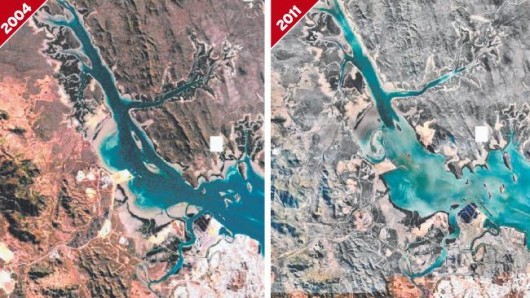 Aerial views show Gladstone Harbour before and after dredging operations began. Aerial views show Gladstone Harbour before and after dredging operations began.
.
An independent report on Gladstone Harbour is scathing of State Government efforts to discover what is causing major disease problems.
The interim report by fisheries veterinarian and Sydney University lecturer Matt Landos says the Government has failed to adequately monitor animal mortality and used untrained observers despite evidence of a crisis.
Dr Landos says the Government has underestimated turtle deaths, made no baseline study of aquatic animal health before the harbour’s 46 million cubic metre dredging began, made no assessment of acoustic impacts and has not investigated dying coral.
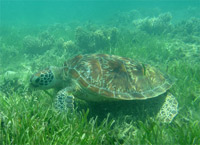
The damning report was paid for by the Gladstone Fishing Research Fund with capital sought from public donations and fishermen.
The port is undergoing major expansion, mostly for the liquefied natural gas industry.
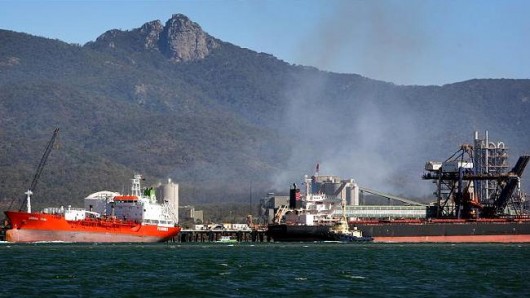 The LNG industrial invasion of Gladstone’s Reef World Heritage Harbour
..when political gas royalties outweigh Queensland Nature
This will be Bligh’s legacy remembered, not her ‘we are Queenslanders’ spiel. The LNG industrial invasion of Gladstone’s Reef World Heritage Harbour
..when political gas royalties outweigh Queensland Nature
This will be Bligh’s legacy remembered, not her ‘we are Queenslanders’ spiel.
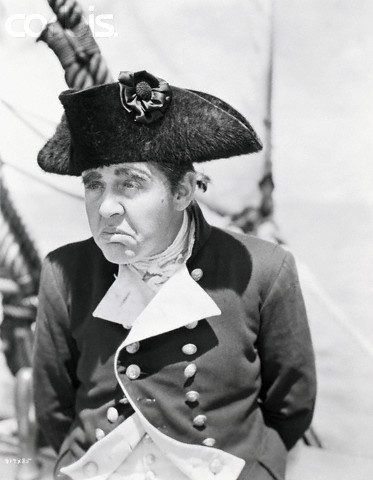 Labor’s mantra: ‘jobs jobs jobs’ – while buggering Australia’s environment and local workers,
because Labor jobs mean foreign 457 jobs,
where Labor selfishly reaps industrial exploitation royalties as if it were a foreign power.
Labor is buggering Queensland’s precious Barrier Reef like it is buggering Queenslanders…all for coal seam gas royalties
Why did old Captain Bligh have a cruel reputation?
. Labor’s mantra: ‘jobs jobs jobs’ – while buggering Australia’s environment and local workers,
because Labor jobs mean foreign 457 jobs,
where Labor selfishly reaps industrial exploitation royalties as if it were a foreign power.
Labor is buggering Queensland’s precious Barrier Reef like it is buggering Queenslanders…all for coal seam gas royalties
Why did old Captain Bligh have a cruel reputation?
.
 Where is Bligh’s empathy for Queensland’s Great Barrier Reef World Heritage? Where is Bligh’s empathy for Queensland’s Great Barrier Reef World Heritage?
.
Former Queensland Seafood Industry Association president Michael Gardner, who helped organise funding, said yesterday that Dr Landos’ findings were at odds with the Government and Gladstone Ports Corporation view, which was that disease was related more to last year’s wet season than dredging.
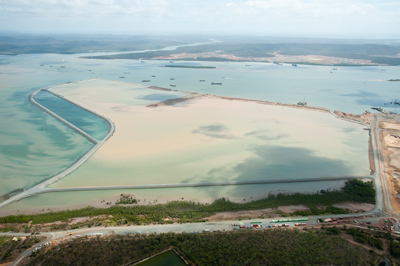 46 million cubic metre dredging of Gladstone Harbour for Coals Seam Gas
Killing dugongs, sea turtles and Reef marine life in the process 46 million cubic metre dredging of Gladstone Harbour for Coals Seam Gas
Killing dugongs, sea turtles and Reef marine life in the process
.
Environment Department director-general Jim Reeves said it was incorrect that studies had not been done to assess the impact of dredging. He said Fisheries Queensland had been conducting an extensive fish health survey since August last year and studies were continuing.
The department had monitored Curtis Island turtle populations for decades before dredging began and there was no evidence of turtle deaths being underestimated. All fisheries observers were trained scientists and surveys were conducted in April and June.
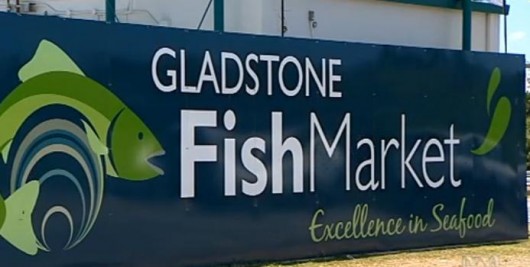 . .
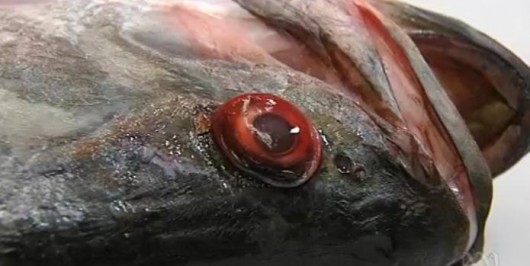 Gladstone now has ‘Exploding Eye’ Barramundi
..thanks Anna Gladstone now has ‘Exploding Eye’ Barramundi
..thanks Anna
.
“So far all we have seen from the Bligh government is flawed water quality monitoring, constant assertions that the problems of marine species’ deaths and fish disease have nothing to do with developments in the harbour and the desire to see developments proceed at breakneck speed.”
“The Gladstone Port Corporation’s dredging program is one of the biggest in our history and we need to know if dredging up historic layers of industrial pollutants as well as the acid sulphate soils that are known to be in the area are linked with this catastrophe.”
.
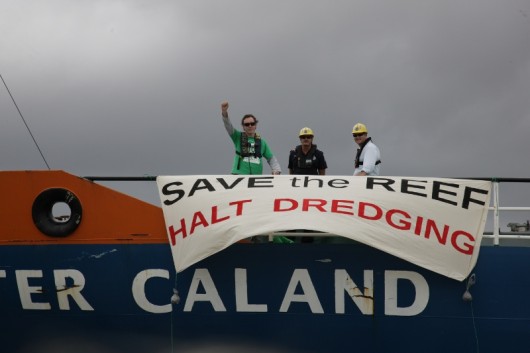 Derec Davies, a Friends of the Earth campaigner
[Source: ^http://indymedia.org.au/2011/11/09/how-to-use-a-bikelock-to-save-the-great-barrier-reef-protest-halts-gladstone-dredging] Derec Davies, a Friends of the Earth campaigner
[Source: ^http://indymedia.org.au/2011/11/09/how-to-use-a-bikelock-to-save-the-great-barrier-reef-protest-halts-gladstone-dredging]
.
Analysis showed water quality was consistent with historical trends, apart from the impacts of the January 2011 floods.
“There is no crisis for the green turtles and dugong that inhabit the area,” Mr Reeves said.
 Australia’s Dugong
A native Queenslander with Existence Rights
has called Gladstone Harbour and its sea grasses home for generations Australia’s Dugong
A native Queenslander with Existence Rights
has called Gladstone Harbour and its sea grasses home for generations
.
Dr Landos said he and Dr Ben Diggles had made preliminary observations of fish health, including barramundi.
“In simple terms, all the barramundi captured were quite sick,” he said. “The vast majority, even those with no apparent external skin abnormalities, displayed tucked up abdomens and all were lethargic when handled. I would not recommend human consumption.”
Dr Landos said that despite the fish having no feed in the gut, there were ample baitfish around upon which they could feed. Mullet sampled did not show any external signs of disease. A population of 27 queenfish were sampled near the dredge spoil dumping ground. All had skin organism infestations and 18 had skin redness.
“My findings … would suggest that the 2010 flood is unlikely to be involved in their causation,” Dr Landos said.
At Friends Point in the inner harbour, 17 of 76 crabs sampled had mild to severe shell changes. At Colosseum Inlet, south of the harbour, 12 of 33 crabs showed signs of lesions. Other problems included mangrove dieback, low fish numbers and few signs of juvenile animals. A final report is expected in one to two months.
.
[Source: ‘Dredging-report-blasts-authorities‘, The Courier-Mail, ^http://www.couriermail.com.au/news/queensland/dredging-report-blasts-authorities/story-e6freoof-1226297658256]
.
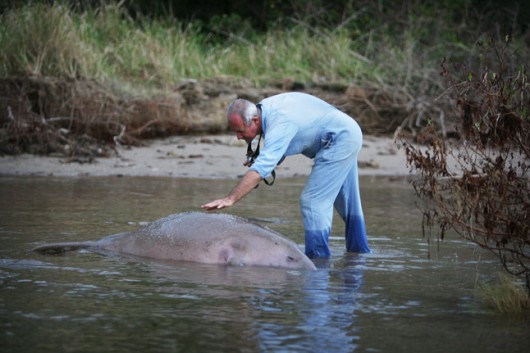 A dead Dugong
– a dead Queenslander in Gladstone Harbour A dead Dugong
– a dead Queenslander in Gladstone Harbour
.
The ABC TV Four Corners current affairs Program 8th November 2011 aired an in depth report on port developments in Queensland and their impact on The Great Barrier Reef Marine Park and World Heritage Area.
Watch: ABC Four Corners programme, by Marian Wilkinson and Clay Hichens: Great Barrier Grief
.
Tags: 46 million cubic metre dredging, Anna Bligh, Anna Bligh poisoning Queenslanders, Artesian Basin, BTEX, Coal Seam Gas, Dugong, Federal Environment Minister Tony Burke, Gladstone Fishing Research Fund, Gladstone Harbour, Goodna, Great Barrier Reef, High Ecological Significance, Liquified Natural Gas, LNG, Queensland Labor, Queenslanders, Toowoomba, Waratah Coal, World Heritage
Posted in Threats from Mining | No Comments »
Add this post to Del.icio.us - Digg
Thursday, August 4th, 2011
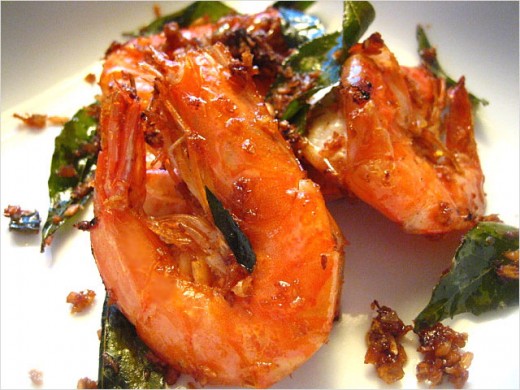 Prawns – an Australian favourite dish Prawns – an Australian favourite dish
[Source: http://rasamalaysia.com/butter-prawns/]
.
Back in 1987 at the formative age of 23, the author worked ten days as a deck hand aboard a prawn trawler off the coast of Townsville in northern Queensland.
Those ten days formed the basis of what would contribute invaluably toward ultimately obtaining a year’s inshore sea time to qualify as a licensed commercial coxswain. But those ten days are also vividly recalled of the experience of the work of a prawn trawler. For those ten days aboard the comparatively small 9.8 metre diesel trawler ‘Charada‘, Frank the skipper, his first mate and I trolled the sea floor along the north Queensland coastline between Townsville and Cape Bowling Green.

My Record of Service log confirms this, as my memory of twenty four years ago is not that acute. My log shows that I later went on to work as a deckhand aboard mainly commercial tourist vessels after that. So my only commercial fishing experience was that short stint aboard the Charada.
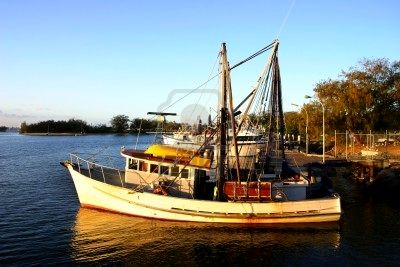 A prawn trawler similar to the ‘Charada’ A prawn trawler similar to the ‘Charada’
.
However, my memory remains vivid of the nightly three shifts we worked, commencing respectively at 9pm, midnight and 3am – hauling in the prawn catch after trawling the sea floor for three hours at a time.
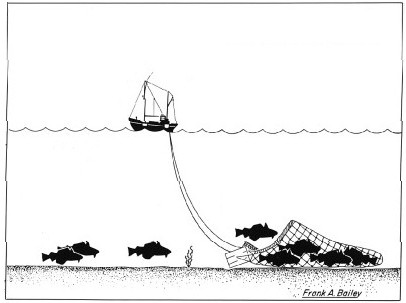
But after tugging the net’s cod end knot, it was not just prawns that ended up on deck’s sorting tray. Everything that lived along the sea floor was dragged into the net by the heavy chain that raked the sandy seabed.
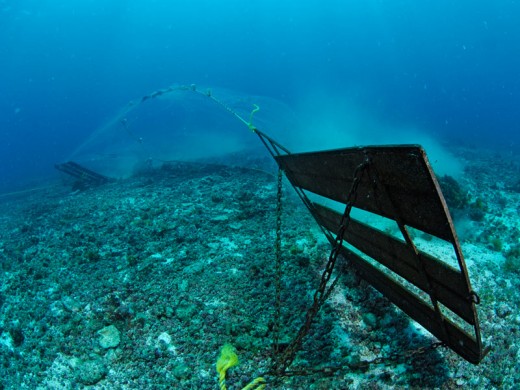 Trawlers raking the sea bed Trawlers raking the sea bed
[Source: http://marksecology.blogspot.com/2011/04/big-fish-review-part-2.html]
.
I recall the variety of creatures that were in the net, the fish, bugs, squids, the odd sting ray, sea snake and the sea urchins and marine sponges. I recall one occasion when the skipper had had to shoot a shark with his .303 which had got caught up in the net. I recall the marine sponges the most because of their strong seaweed like stench, and it was this stench in particular that caused me, a Victorian landlubber up until then, to become queasy. I was sea sick by the smell more so than the motion of the boat. I didn’t generally get sea sick.
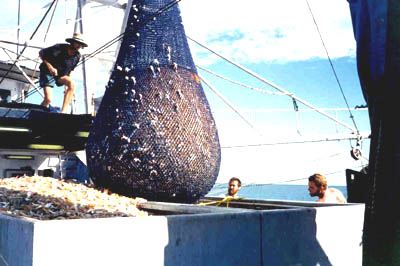
For those ten days on that small trawler for three shifts a night, we raked the seabed of its marine life. We only wanted the banana prawns which we sorted into white plastic tubs, covered with ice and snap frozen in the freezer down below. The rest of the smelly marine creatures we tossed back overboard – dead.

I recall watching the depth sounder next to the boat’s wheel, displaying the colourful array of marine life activity (prawns).
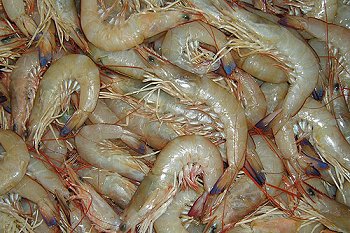
But then later in the trip there were no colours, just a blank screen, so we headed back to Townsville. The sea bed was just sand after our chain had dragged and raked the sea bottom. Nothing was left alive.
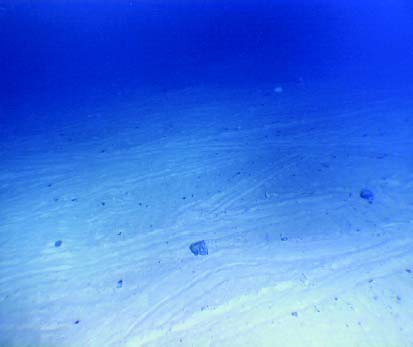 Typical sea bed after trawling Typical sea bed after trawling
Though hard manual labour and night shifts, the whole trawling process was pretty straight forward – head out to sea, throw the net over, trawl for three hours, haul in, sort the prawns from the rest, freeze ’em, then after the freezer was full head back in sell ’em and go to the pub. A simple life.
That was my brief introduction to Queensland prawn trawling. Yet looking back, the Charada was just one of hundreds of prawn trawlers that plied the Queensland coastline. It was just ten days out of many years and decades of similar fishermen doing their trade since perhaps the 19th Century. One must consider then how can there be any marine life left in Queensland inside the Great Barrier Reef? At the age of twenty three I just accepted that trawling was a normal legitimate Queensland industry. I hadn’t considered the environmental impact at the time. The work was there.
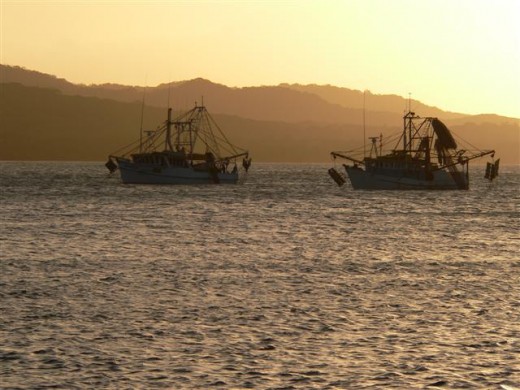
.
.
For years the Queensland Fisheries Service (QFS) has assured that commercial prawn trawling has met strict environmental guidelines. This has supported the prawn industry continuing to earn lucrative revenues from both domestic and export markets. This has been reassuring, after all the World Heritage listed Great Barrier Reef is not far away.
In 2005, Queensland’s Fisheries Research and Development Corporation (FRDC) and Fisheries Queensland jointly funded a marine research project called ‘Reducing the impact of Queensland’s trawl fisheries on protected sea‘. This research project measured the incidental catch and fishing mortality of sea snakes in the Queensland trawl fishery.
By 2008, the project had concluded that about 105,000 sea snakes were being caught annually in the fishery, with about 26% dying as a result. The effect of bycatch reduction devices (BRDs) on the catch rates of sea snakes and prawns was also evaluated, as part of the project. One BRD in particular, known as the fisheye BRD, was highly effective at excluding sea snakes from trawl nets, with no reduction in prawn catch rates. As a result of the project, trawler operators are now being encouraged to install fisheye BRDs in their nets to reduce their impacts on these protected snakes.’
[Source: Queensland Department of Primary Industries and Fisheries, ^ http://www.dpi.qld.gov.au/28_5193.htm ]
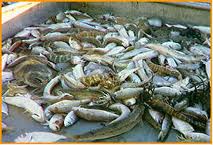
Example of sea snakes caught in catch
.
.
.
So all that unwanted marine life we had been throwing overboard the Charada was officially termed ‘bycatch‘. Sea snakes are protected species in Australia and therefore measures need to be implemented to minimise commercial fishing impacts on them, plus the many other bycatch that may happened to be threatened and endangered.
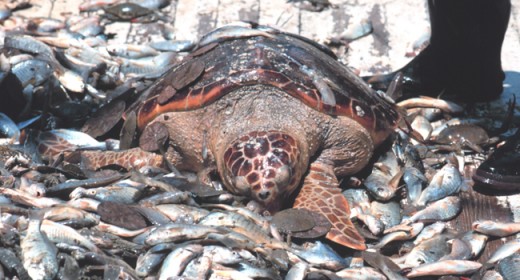
.
.
Then yesterday The Queensland Times reported the following article:
.
‘Net fishing damaging marine life’
.
[Source: ‘Net fishing damaging marine life’, The Queensland Times, 20110803, ^http://www.qt.com.au/story/2011/08/03/net-fishing-damaging-marine-life-report/ , accessed 20110804]
.
‘Trawler fishing is devastating slow growing marine life and damaging Australia’s oceans, a new report has found.
The study by environmental consultancy J Diversity has found that seafloor fishing and gill netting is “indiscriminate” in its impact on marine life.
Less than five per cent of Australian waters are protected from fishing and mining. It found in the south-west marine region gill nets up to eight kilometres wide are decimating shark and ray species.
NT Environment Centre director Stuart Blanch said the practice of trawling is as destructive as the clear-felling of forests on land and “death nets” must not further damage feeding and breeding areas for marine life.
“Trawling is one of most indiscriminate fishing methods. It produces only two per cent of wild fish harvest but up to one third of its bycatch,” Dr Blanch said.
The report says the WA South Coast Shark Fishery and Great Australian Bight Trawl Fishery catch at least 34 and 50 shark and ray species but discard around one third of the catch. It also says most Australian stocks have been fished to between 20 to 40 per cent of their unfished biomass, below the threshold of 75 per cent recommended by scientists to ensure fish stocks are conserved. Gavan McFadzean from The Wilderness Society called on federal Environment Minister Tony Burke to rule out any move that would benefit seafloor trawling or gill net fishing in new marine sanctuaries.
“If the Minister allows these death nets into important feeding and breeding areas, he would undermine the government’s election commitment to improve protection of our marine life,” he said.
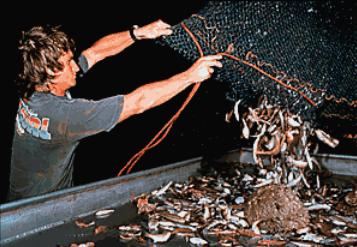 Brings back memories of my ten days on the prawn trawler Brings back memories of my ten days on the prawn trawler
.
.
Back in 1987, at age 23 I was clearly naive about what I was involved in, but governments and fisheries cannot feign naivety.
.
Yesterday’s response comment by ‘Atrax’ from Maroochydore is apt:
.
“Gees it took a new megabucks report to tell you this?
We sure have some geniuses in the Australian Marine management departments.
Of course it damages marine habitat and spawning sites.
This has only been known for the last 50 years, they banned Scallop dredging in Port Phillip bay because of this 35 years ago.
The bycatch destroyed in purse seine and gill netting is mind blowing.
Just shows how useless the drones in these departments really are.”
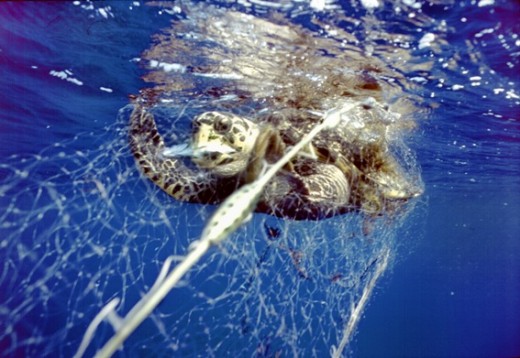
.
.
‘Satellite images reveal trawling damage’
.
[by Robert Shikina, rshikina@starbulletin.com, ^http://archives.starbulletin.com/2008/02/25/news/story01.html, accessed 20110804]
.
‘Bottom trawling, a fishing practice that involves dragging a net along the seabed behind a boat, causes extensive damage that can even be seen from space, a Hawaii scientist reports.
“There is a massive amount of mud that gets kicked up,” said Les Watling, a professor of zoology at the University of Hawaii.
He joined other scientists in a presentation on the problem last week in Boston at the annual meeting of the American Association for the Advancement of Science.
Trawling is not a problem in the deep waters around Hawaii, since the method is used in waters less than about a mile deep, but areas where it is used sustain a significant loss of marine life, he said. “It does more harm to the sea floor than any other kind of fishing, and now we have images from space showing how much sediment it lofts into the water column,” added Elliot Norse, president of Marine Conservation Biology Institute.
A University of Hawaii zoologist is among a group of scientists decrying the destructive effects of bottom trawling, a type of fishing, visible in satellite images from space. “We’re hoping that people will have a look,” said Les Watling, a professor of zoology at the University of Hawaii. “There is a massive amount of mud that gets kicked up.”
The satellite images of mud trails kicked up by bottom trawling are available on the Web site www.skytruth.org, inside the gallery and labeled as “trawling impacts.”
Watling, who has been working for about 15 years on limiting the effects of trawling, added that 99 percent of the areas that are trawled cannot be seen by a satellite. He was a panelist in a session that discussed the effects from bottom trawling at the annual meeting of the American Association for the Advancement of Science this month in Boston. Since trawling cannot be done in waters deeper than 6,500 feet, it is not a problem around Hawaii, but in areas where it is used, there is usually a significant loss of marine life, scientists say. Trawling equipment can be about 150 feet across and weigh half a ton. In its wake the trawling nets leave nothing but rubble, killing sponges and coral on the sea floor. Bottom trawling is used to catch shrimp and other bottom fish such as cod.
“Trawling removes much of the life from the sea floor,” said Elliot Norse, president of Marine Conservation Biology Institute, who participated in the session.
.
“The effect is basically to denude the sea floor.”
.
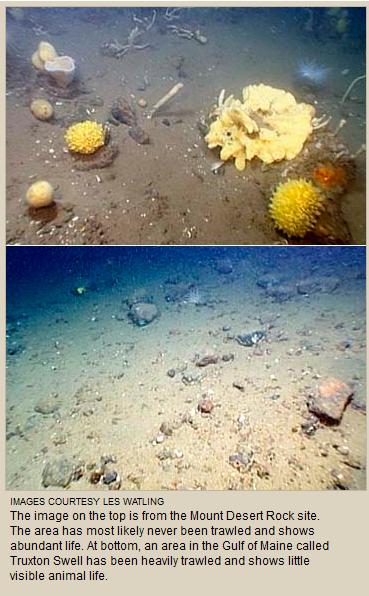
He said bottom trawling catches more unwanted fish and does more harm to the sea floor than any other kind of fishing. The sediment disturbing the water column can also clog fish gills, possibly reintroduce absorbed carbon into the water and kick up toxic materials that have settled to the bottom, Norse said.
“Now we have images from space showing how much sediment it lofts into the water column,” he said. “Not just affecting the sea floor, it also affects the water column.”
Ten years ago, Norse and Watling completed a study that found bottom trawling covers an area the size of the continental United States every year. John Amos, president of skytruth.org, used the detail in satellite images from Google Earth to discern the fishing vessels creating the squiggly sediment trails from bottom trawling. He gathered satellite images from the U.S. Geological Survey of fishers using bottom trawling in the Gulf of Mexico and China.
“I think that what’s exciting about this imagery is it’s one of the few examples where we can provide people with visual truth of what we’re doing to the oceans,” Amos said. “Imagery from space can actually show what we’re doing to the bottom of the ocean floor. When you show people images they understand, they get it in ways that thousands of pages of reports doesn’t quite communicate.”
.
– end of article –
.
.
Tags: bycatch, fish habitats, gill netting, Great Barrier Reef, inshore beam trawl fishery, Les Watling, Marine Conservation Biology Institute, marine habitat, marine sanctuaries, overfishing, prawn trawling, protected sea snakes, Queensland marine life, seafloor fishing
Posted in Threats from Fishing | No Comments »
Add this post to Del.icio.us - Digg
|
|
 Smoking Ceremony or Smoke and Mirrors?
Staged for the delegates by National Parks and Wildlife Service of New South Wales (NPWS), somewhere outside Sydney, Australia
[Source: ‘Global First Nations environmentalists share stories at the World Parks Congress in Sydney.5:30’, ^https://twitter.com/nitvnews, 20141113]
Smoking Ceremony or Smoke and Mirrors?
Staged for the delegates by National Parks and Wildlife Service of New South Wales (NPWS), somewhere outside Sydney, Australia
[Source: ‘Global First Nations environmentalists share stories at the World Parks Congress in Sydney.5:30’, ^https://twitter.com/nitvnews, 20141113]
 Dredging the Great Barrier Reef for bulk export shipping
Dredging the Great Barrier Reef for bulk export shipping  Mass tourism operators good for the economy
Getting up close to protected Humpback Whales within their 100 metre Protected Area
Mass tourism operators good for the economy
Getting up close to protected Humpback Whales within their 100 metre Protected Area
 Protest to stop Queensland Resources Council dumping dredge spoil inside the Reef
Protest by Cairns and Far North Environment Centre (CAFNEC), June 2014
^http://cafnec.org.au/wp-content/uploads/2014/03/rally-promo-photo.jpg
Protest to stop Queensland Resources Council dumping dredge spoil inside the Reef
Protest by Cairns and Far North Environment Centre (CAFNEC), June 2014
^http://cafnec.org.au/wp-content/uploads/2014/03/rally-promo-photo.jpg
 White Lemuroid Possum
(Wet Tropics of Queensland World Heritage Area in Danger)
Has the white lemuroid possum become the first mammal to go extinct due to global warming?
White Lemuroid Possum
(Wet Tropics of Queensland World Heritage Area in Danger)
Has the white lemuroid possum become the first mammal to go extinct due to global warming?






















































































